Homepage > GMAT IR and AWA > GMAT Analytical Writing Assessment tips – How to score a perfect 6 on GMAT AWA

GMAT Analytical Writing Assessment tips – How to score a perfect 6 on GMAT AWA
Posted by Suheb Hussain | Aug 6, 2020 | GMAT Focus Edition , GMAT IR and AWA , GMAT Preparation

The GMAT Analytical Writing Assessment (AWA) section measures your ability to analyze an argument and communicate your thoughts or ideas. What you simply need to do is to critically analyze the reasoning given behind a given argument. To complete the AWA section of the GMAT you are allotted 30 minutes.

Here is the outline of the article:
How to create a well rounded Analytical Writing Assessment essay?
- How does ‘GMAT Write’ analyze your AWA essay?
GMAT AWA tips – GMAT Analytical Writing Assessment Template
- Sample GMAT Analytical Writing Assessment essay
Let’s discuss now how you can score a perfect 6 on the GMAT Analytical Writing Assessment section. Here are a few tips to prepare you for the GMAT AWA section.
Step 1 – Understand the process of creating a well-rounded analysis of an argument. You can do that in two ways or rather with the help of two tools.
- AWA template by Chineseburned from gmatclub
Step 2 – Practice! Practice! Practice! the AWA questions. Here is a list of practice questions for you.
GMAT Write – An AWA practice tool by GMAC
GMAT Write is a writing tool provided by GMAC. It gives you access to 2 unique essay prompts and a chance to write 4 essays. The good thing about this tool is that it scores your essay based on the scoring algorithm used by the official GMAT exam. But, it costs $29.99 to subscribe to this tool.
Take a look at this article to know the importance of AWA and IR sections for business school admissions.
How does the ‘GMAT Write’ analyze your GMAT AWA essay?
Once you submit an essay, it scores you on 4 categories:
- Analysis of the issue
- Supports ideas
- Organizes coherent idea
- Language control
Based on these 4 categories it gives you an overall score for the essay.
Even if you don’t buy this tool, you still get to know what GMAT considers an ideal essay to be from it. An ideal essay should:
- Identify and analyze significant flaws in the argument
- Support the critique using relevant supporting reasons and/or examples
- Be a clearly organized and coherent response
- Demonstrate control of language, including diction, syntax, and conventions of standard written English
Source: https://www.mba.com/exam-prep/gmat-write
Once you know what factors make a perfect essay, the next thing you should do is creating a template. The most popular template for AWA is the one provided by ‘Chineseburned’ user on the gmatclub forum.
If you are planning to take the GMAT, we can help you with a personalized study plan and give you access to quality online content to prepare. Write to us at [email protected] . We are the most reviewed GMAT prep company on gmatclub with more than 1950 reviews. Why don’t you take a free trial and judge for yourself?
Here are the details of his template:
Structure of the essay
- Introduction: Restate the argument and point out the flaws. Now, state your views which you’ll discuss in the next paragraphs.
- First paragraph: State your first critique of the argument and support your view with an example.
- Second paragraph: State your first critique of the argument and support your view with an example.
- Third paragraph: Pose a few questions for the argument. The absence of information in the argument to answer your questions weaken it further.
- Fourth argument: State information that you feel would have strengthened the argument but is absent. (This is an extra paragraph which is not in Chineseburned template)
- Conclusion: State that the argument is flawed because of the above reasons and which reasons could have strengthened the argument.
Learn how the IR section is scored.
Sample GMAT Analytical Writing Assessment AWA essay
Here is a sample AWA essay question for practice. We have also provided the answer to this question based on the template.
The following appeared in an Excelsior Company memorandum. “The Excelsior Company plans to introduce its own brand of coffee. Since coffee is an expensive food item, and since there are already many established brands of coffee, the best way to gain customers for the Excelsior brand is to do what Superior, the leading coffee company, did when it introduced the newest brand in its line of coffees: conduct a temporary sales promotion that offers free samples, price reductions, and discount coupons for the new brand.” Discuss how well reasoned you find this argument. In your discussion, be sure to analyze the line of reasoning and the use of evidence in the argument. For example, you may need to consider what questionable assumptions underlie the thinking and what alternative explanations or counterexamples might weaken the conclusion. You can also discuss what sort of evidence would strengthen or refute the argument, what changes in the argument would make it more logically sound, and what, if anything, would help you better evaluate its conclusion.
GMAT AWA essay
The Excelsior company wants to introduce its own brand of coffee since coffee is an expensive food item and might have good profit margins. However, as there are several established brands of coffee already, it needs to work out a way to gain a foothold in the market. For this purpose, the company plans to pursue the same marketing strategy that the leading coffee company Superior had used. However, I think there are several flaws in that line of reasoning. And hence this argument seems a little weak.
First, Superior is already an established brand and the market leader. No data is given as to how long back it entered the coffee market. Without this information, it is difficult to ascertain the utility of the marketing strategy for Excelsior. A brand might take decades to establish, and what worked a decade back, need not work today. For example, when Google was initially set up, it depended on word of mouth, rather than any communication media, for its marketing. As it was initially just an internal product for the University, this approach worked for them. However, it might not work for any company now. We see these days that most new web companies do advertise heavily when they initially launch a product for the masses.
Second, no information has been provided about the target market for the coffee or the pricing strategy. It might be that the coffee produced by Superior is one of the cheaper products in the market. And that they earn their profits from volume sales rather than having a niche market. Whereas, Excelsior might be aiming at the niche market of expensive and luxury coffee. If that were the case, then the same marketing strategies might not be relevant for Excelsior. Can Hyundai apply the same approach towards the market as does a luxury brand like Ferrari?
Without some of the relevant and contextual details, it is difficult to judge the efficacy of using the same marketing strategy that a competitor applied some unknown years back. If we were to get some more details in this regard, we could have judged the situation better.
Although all the factors being the same, it might not be a bad idea to follow the same approach as that of a leading brand in the market. Sometimes there is nothing wrong with sticking to the tried and the tested. In the absence of any other better idea, Excelsior might not have much to lose if it pursues the same methods as did Superior. It’s better to have some plan rather than no plan.
Conducting a temporary sales promotion that offers free samples, price reductions and discount coupons might not be such a bad idea. It could be a good ploy to get users to try out the product. And discounts and other monetary incentives are usually very effective in this regard. If the quality of the product is good enough and the pricing is appropriate, introducing enough customers to the product through such offers might give a significant push to consumer interest in the product. While customer satisfaction might leverage word of mouth marketing.
Therefore, depending on the context the approach might or might not be a beneficial one. This essay question has been taken from gmatclub and the answer has been judged as a perfect 6 by the GMAT Write tool. The answer was written by the user ‘rish2jain’ from gmatclub forum.
To score a perfect 6 on the GMAT Analytical Writing Assessment section, it is important that you learn the AWA template and practice as much as you can. Just don’t overdo it. It is a good practice to devote 10% of your preparation time to GMAT Analytical Writing Assessment section.
About The Author

Suheb Hussain
Don't limit yourself, don't miss these.

Helpful posts Curated just for you!

You might also like

Browse Related Topics

Achieve 685+ on the GMAT in 30 days!
Sign up for our free trial and get.
400+ Practice questions with detailed solutions
10+ hours of ai-driven video lessons, adaptive mock test with osr+ analysis.
Begin your GMAT Prep today!
What is a Good AWA Score on the GMAT?
Last Updated on November 23, 2023
A solid GMAT score goes a long way in increasing an applicant’s competitiveness for MBA admissions, so it’s not surprising that most MBA applicants recognize the importance of earning a competitive overall GMAT score .
However, many GMAT-takers wonder whether their scores on the essay portion of the GMAT, which is known as the Analytical Writing Assessment (AWA) section, also affect their competitiveness in MBA admissions, and if so, what constitutes a good GMAT AWA score. In this article, we’ll answer these and other common questions about the GMAT essay.
Let’s begin by discussing what the GMAT AWA is.
The GMAT AWA
Gmat awa percentiles, how important is the gmat awa section for mba admissions, what is a good gmat awa score.
The GMAT Analytical Writing Assessment (AWA) measures your ability to examine and assess the underlying reasoning behind an argument, and then present your critique in the form of a written essay.
The GMAT AWA measures your ability to examine and assess the reasoning behind an argument, and then present your critique in the form of a written essay.
Specifically, for the GMAT AWA, you’ll be presented with a one-paragraph prompt that contains a scenario or argument, which is often presented in the context of a statement provided by a company or a newspaper editorial.
Regardless of which AWA prompt you’re given, the argument will be flawed in some way(s). For example, the argument may contain flawed logic, faulty assumptions, conclusions that are supported by inadequate evidence, issues in the way supporting data was collected, or unreasonable comparisons.
The goal of your essay is simple: expose these flaws!
The goal of your GMAT AWA essay is simple: in a well-organized essay, expose the flaws present in the argument prompt.
According to the GMAC, an ideal essay should:
- Identify and analyze significant flaws in the argument
- Support the critique using relevant supporting reasons and/or examples
- Be clearly organized and coherent
- Demonstrate control of language, diction, syntax, and conventions of written English
You’ll have 30 minutes to read the prompt and write your essay. The good news is that with some practice and the right strategies, earning a perfect score on the GMAT AWA section is within reach for most GMAT test-takers.
On the GMAT, you have 30 minutes to read the AWA prompt and write your essay.
Let’s now discuss how the AWA is scored.
How the GMAT Analytical Writing Assessment (AWA) Section is Scored
Many GMAT-takers wonder whether the GMAT AWA counts toward their GMAT score. The GMAT AWA has its own unique score that does not count toward a test-taker’s overall GMAT score of 200 to 800 .
The GMAT AWA has its own unique score that does not count toward a test-taker’s overall GMAT score of 200 to 800.
The GMAT AWA is graded on a scale of 0 to 6, in half-point increments. According to the Graduate Management Admission Council (GMAC), a score of 6, the highest possible score, is considered “outstanding,” 5 is “strong,” 4 is “adequate,” 3 is “limited,” 2 is “seriously flawed,” and 1, the lowest score possible, is considered “fundamentally deficient.”
Your GMAT AWA essay will be graded once by a human reader and once by a computerized grading program. If these two scores differ by one point or less, the two scores will be averaged to yield your final scaled score. So, for example, if the human grader gives you a 5 and the algorithm gives you a 6, your final scaled score will be 5.5. If the two scores differ by more than one point (for example, the human grader gives you a 4 and the algorithm gives you a 6), then a second human grader will step in to grade your GMAT AWA essay and help determine your final score.
Your GMAT AWA essay will be graded once by a human reader and once by a computerized grading program.
Now that we understand the basics of how the AWA is scored, let’s review the GMAT AWA percentiles.
Just as your other section scores are associated with percentile rankings, your AWA score will be associated with a score percentile. These percentile rankings allow you (and schools) to see how your GMAT AWA score compares to those of other GMAT test-takers.
Let’s now discuss how important the GMAT AWA is for MBA admissions.
Out of every scored section of the GMAT, the AWA section probably carries the least importance for admissions to business schools. However, it would be a mistake to assume that having the least importance is the same as having no importance. In fact, the GMAT analytical writing score does matter for MBA admissions.
The GMAT AWA score DOES matter for MBA admissions.
The reason that the GMAT AWA score matters is that the purpose of the AWA section is to determine how well you’re able to convey ideas in written form, a skill that will be of utmost importance in business school and beyond. After all, how clearly you’re able to communicate in written form will have a significant impact on your success as an MBA student and as a business professional.
So, don’t neglect preparing for the AWA section!
Now, how much the GMAT AWA section matters to you is a function of a number of variables, some of which are easy to quantify.
If you’re applying to an M7 MBA program, such a Harvard Business School or Stanford Graduate School of Business , or a top 10 MBA program, then your GMAT AWA score will be of greater significance than it will if you’re applying to, for example, a top 25 MBA program. Thus, if you have your sights set on a top school, you’ll want to earn a 5 or above on the GMAT AWA. In fact, to be safe, a score of 5.5 or 6 should probably be your goal. After all, why let a low AWA score jeopardize your chances of admission to a great MBA program , right?
If you’re a nonnative speaker of English, then your GMAT AWA score might be of greater significance than it would be if English were your first language. With a few notable exceptions, the language of business and business schools is largely English. Therefore, business schools seek to ensure that their students have a strong command of written English. The good news is that if English is your second language, you can lean into preparing for the AWA, earn a strong AWA score, and leverage this score to help you stand out among the pack of other applicants whose native language is not English. Thus, if you’re a nonnative English speaker, you’ll want to earn a 5 or above on the GMAT AWA section.
If English is your second language, earning a GMAT AWA score of 5 or above can help you stand out among the pack of other MBA applicants whose native language is not English.
If you’ve scored 4 or below on the AWA section, you might want to consider retaking the GMAT . Such a low score could raise some red flags and signal to MBA admissions committees that your writing skills are not developed enough that you’ll be able to handle the coursework in their programs.
In addition, a large disparity between the level of writing in your GMAT AWA essay and the level of writing in your MBA application essays could cause admissions to wonder who actually wrote — or helped you to write — your application essays. Of course, no one wants a situation like that when applying to business schools.
A large disparity between the level of writing in your GMAT AWA essay and the level of writing in your MBA application essays could cause admissions to wonder who actually wrote — or helped you to write — your application essay.
So then, what is a good GMAT essay score?
A good GMAT AWA score is one that serves as an asset for your applications to business school. For almost all GMAT test-takers reading this article, a good GMAT essay score is 5 or above.
Does that mean that an applicant will not be accepted to business school without an essay score of 5 or above? No, of course not. People are accepted to a wide range of MBA programs with AWA scores lower than 5, especially if their total GMAT scores and work experience are impressive. However, why risk giving admissions committees any reason to doubt your ability to thrive in an MBA program environment? Spending a bit of time to prepare yourself to earn a 5 or higher on the GMAT AWA is a small investment that could pay big dividends.
Spending a bit of time to prepare yourself to earn a 5 or higher on the GMAT AWA is a small investment that could pay big dividends.
You May Also Like...
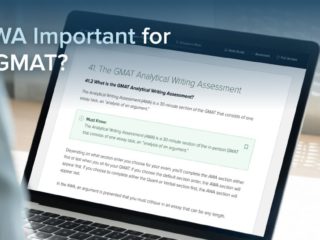
About The Author
Scott Woodbury-Stewart is the founder & CEO of Target Test Prep. A passionate teacher who is deeply invested in the success of his students, Scott began his career teaching physics, chemistry, math, and biology. Since then, he has spent more than a decade helping students gain entry into the world’s top business schools, logging 10,000+ hours of GMAT, EA, GRE and SAT instruction. Scott also served as lead content developer and curriculum architect for the revolutionary courses Target Test Prep GMAT, Target Test Prep EA, Target Test Prep GRE and Target Test Prep SAT Quant.
Leave a Reply Cancel Reply
Save my name, email, and website in this browser for the next time I comment.


How to write your GMAT AWA Essay [Effectively]

INTRODUCTION
Hello there!
If you’ve found your way to this blog, we assume that you have begun to think about that often-neglected section of the GMAT – the AWA!
If wishes could come true, we’re guessing that GMAT aspirants would have wished away the AWA section away by now!
The AWA involves staring at a blank page and cursor and thinking up stuff to write, not an easy task for many people.
It also consumes a lot of mental bandwidth at the very beginning of the test.
To top it off, it does not even add to your final score!
We can understand why it isn’t your favorite section on the GMAT 🙂
But here’s the good news! There are not many shortcuts to mastering GMAT Quant and Verbal, but there are shortcuts to cracking the AWA section.
By the time you finish reading this guide, you will know what these hacks are. You will learn how to write an effective AWA essay that gets you a good score and leaves you charged for the real test that lies ahead.
This blog will teach you –
- What you need to know BEFORE you start preparing for the AWA
- How to use the 30 minutes allotted to AWA to maximum effect
- How to use a template to make the AWA writing process simpler
Besides this, you will find 8 sample AWA essays to observe and learn from.
Happy reading! 🙂
7 Things to remember before you start prepping for the AWA

Before you dive into AWA preparation, there are a few things you should know about the AWA. Many of these facts will ease your AWA fears and bring a smile to your face!
1. Why is the AWA section on the GMAT?
Each section of the GMAT is carefully constructed ( at the expense of millions of dollars, we kid you not!), to test your readiness for an MBA program and for your post-MBA career. One of the skills you will definitely need post-MBA is an ability to analyze an argument impartially and convey your perspective clearly.
This is what the AWA tests you on.
2. On the AWA, you need to be a lawyer, that is, you need to find faults with the given argument. You do not need to be a journalist, that is, you do not need to write about all possible perspectives of an issue.
Also remember, that this is an analysis, not an opinion piece. Do not bring YOUR perspective and your opinions into the essay. Your only goal is to analyse the given argument.
3. Unlike the Quant and Verbal sections, where your thumb-rule should be to get as high a score as possible, we’d suggest that you do not expend too much mental energy on the AWA, trying to score a 6 on 6.
Getting a perfect 6 will look good on your GMAT score card, and will sound great as you’re telling your friends about it. But it will not be the make-or-break factor in your application. A 4 or a 5 is good enough.
4. The AWA is graded by an E-reader application and by a human reader. Since there is an element of automated grading, you can rig the test to an extent. We’ve found that if you write a substantial essay of over 500 words, and if you structure the argument well ( check our CrackVerbal template in the following chapter), you are almost guaranteed to get a 4+ score!
5. Assuming that you prepare for the GMAT over a course of three months, we recommend that you practice writing 5 to 10 essays, and make sure you get feedback for all of them. If you cover this much practice ground, you’re good to go!
6. One of the best things about the AWA section is that you know all of the questions beforehand (yes, they’re all up there on the GMAC site – Analytical Writing Section ). So you do not have to go hunting for ‘authentic’ AWA essay questions.
7. Now you can choose the order in which you want to take up the sections before starting the test. It is advisable to keep in mind the order that would be helpful for you and prepare for the AWA based on that strategy. This is a recent change to the GMAT test structure. It was introduced in July 2017. We have done a detailed analysis of what this means to an Indian GMAT test-taker in the this blog
8. We saved the coolest point for last 🙂
The AWA lends itself very easily to the use of an essay template. No matter what the argument prompt is, you can bet that there will be at least 3 glaring errors of logic in it. You can, therefore, use a template to structure your AWA essay. Using a template takes most of the stress away from the AWA section.
In the few minutes before you start, you can jot down the template on your scratchpad, so that you don’t have to remember it anymore. Also, because you can plan many of your sentences beforehand, you can get at least a 100 words down before you even read the question!
There are a lot of templates on the internet – probably the most famous one being the Chineseburned AWA template.
At CrackVerbal, we have our own template for the AWA, a modified version of the Chineseburned template. We call it the CrackVerbal AWA Template on Steroids! 🙂
The AWA Writing Process

1. Write your templatized response
This should take you about 5 minutes:
Type out your prepared template response. Below is a sample. We definitely do not recommend that you use the same words. What you can do, however, is read a few templates on the net, and then write your own. Since you have written it yourself, it will be that much easier to memorise it.
CRACKVERBAL AWA TEMPLATE
The argument claims that < restate the argument >. Stated in this way the argument fails to take into account a few key factors which could call the conclusion to question. It rests on some assumptions, for which there is no clear evidence. Therefore, the argument is unconvincing and falls apart at the seams.
Paragraph 1:
1. Firstly, ( ) 2. This statement is a stretch and not substantiated in any way. 3. The argument would have been much clearer if ( )
Paragraph 2:
1. Second ( ). This is again a very weak and unsupported claim as the argument ( ). 2. For example, 3. This argument would have sounded a lot more convincing if 4. In addition, it would have been strengthened ever further if the argument provided evidence that
Paragraph 3:
1. Finally, the argument concludes that 2. However, what is not clear here is ( ) 3. If there had been evidence to support ( )
In summary, the argument fails to convince because of the faulty assumptions aforementioned. If the argument had drawn upon examples as suggested, and thereby plugged in the holes in the reasoning, it would have been far sounder on the whole.
2. Brainstorm
Now that you have put the pre-planned portion of the essay down, it’s time to read the AWA prompt and wear your thinking hat. GMAT, in its politically correct, non-partisan way, says ‘Discuss how well-reasoned you find this argument’. Remember however, that an AWA argument is never well-reasoned!
There are always a couple of glaring flaws in logic you can pounce on. If these flaws do not occur to you immediately, because of test-day stress, do not assume that you have been given a particularly sound argument. There is no such thing on the AWA!
If you’re unable to be critical, imagine that the author of the argument is somebody you dislike..a teacher you hated at college, or that guy who overtook you and almost dented your car this morning! There, now you’re in the right frame of mind to attack the argument 🙂
Before you do so, you need to understand the three elements of the argument – Conclusion, Premise and Assumptions.
Let us look at an example, and detect these three elements.
“Most companies would agree that as the risk of physical injury occurring on the job increases, the wages paid to employees should also increase. Hence it makes financial sense for employers to make the workplace safer: they could thus reduce their payroll expenses and save money.”
The conclusion is the decision/statement that the author has arrived at. In this case, the conclusion is the last sentence – “Hence it makes financial sense for employers to make the workplace safer: they could thus reduce their payroll expenses and save money.”
The premises are the building blocks of facts on which the conclusion rests. In other words, a premise is what is offered as support for the conclusion. In this case, the premise is – Most companies would agree that as the risk of physical injury occurring on the job increases, the wages paid to employees should also increase.
Assumptions are the unstated, unwritten premises that plug the gap between the written premises and the conclusion. It is the assumptions that you need to attack on the AWA!
How do you attack assumptions?
Remember that an assumption can be incorrect for a variety of reasons. Here are a few types of incorrect assumptions –
1. The Sampling Assumption – The sampling argument assumes that a small group is representative of a much larger group to which it belongs.
2. The illogical analogy assumption – The illogical analogy states that because something applies to A, it applies to B also.
3. The Causal Assumption – The Causal Assumption confuses correlation with causation. That means, just because ‘A’ usually occurs after ‘B’ occurs, does not necessarily imply that B happens because of A.
4. The Data Bias – This occurs when the data for a statistical inference itself is drawn from a sample that is not representative of the population under consideration. This is a case of faulty data leading to faulty assumptions.
5. The Non Sequitur – This simply means, finding a connection where there is none. Non Sequitur means “does not follow,” which is short for: the conclusion does not follow from the premise.
Don’t let these categories overwhelm you. We’ve put them down here to get you thinking. However, you can find faulty assumptions with ease, even if you have no clue what a non sequitur is!
As you brainstorm, you will need to jot down your thoughts on the scratchpad. Keep it crisp and brief. Make sure you have these things down –
1. Conclusion + Premise: 2. Flawed Assumption #1: 3. Flawed Assumption #2: 4. Flawed Assumption #3:
For each assumption, also make a cursory note of why it is flawed, an example that talks about why it is flawed, and what additional data would strengthen the argument ( or if you are convinced that you can remember these additional details without having to make a note of them, you can get on with the writing! )
This should take you about 15 minutes:
Here is where you fill in your templatized response with specific details.
The only detail you need to add to the first paragraph is a summary of the argument that is presented. In the above template, your summary should go here ->
1. Start off by pointing out the first flawed assumption. 2. Explain why this assumption is flawed. 3. Give an example that supports the flaw. 4. Explain what further information could have strengthened this argument.
1. Start off by pointing out the second flawed assumption. 2. Explain why this assumption is flawed. 3. Give an example that supports the flaw. 4. Explain what further information could have strengthened this argument.
Paragraph 4:
1. Start off by pointing out the third flawed assumption. 2. Explain why this assumption is flawed. 3. Give an example that supports the flaw. 4. Explain what further information could have strengthened this argument.
Paragraph 5:
This is the concluding paragraph. You already have it down in your template! 🙂
4. Proofread
Are you wondering if three minutes is really enough time to proof-read a 500 word essay?
Here’s the deal – The AWA section is about whether you can analyse an argument and discuss it in an articulate manner. It is not a test of grammar and spelling. Hence, the GMAT will excuse minor errors in spelling and grammar.
However, you should understand that a human reader is going to be reviewing your work, and any human reader will have an unconscious bias against bad grammar and spellings. Hence, you want to keep your essay as error-free as possible, without worrying about it too much.
Three minutes should be able time for you to quickly glance through the document and make sure you haven’t made any obvious errors.
Voila! 🙂 Your AWA essay is ready!
Also Read: GMAT Section Selection – Everything you need to know
Sample AWA Essays
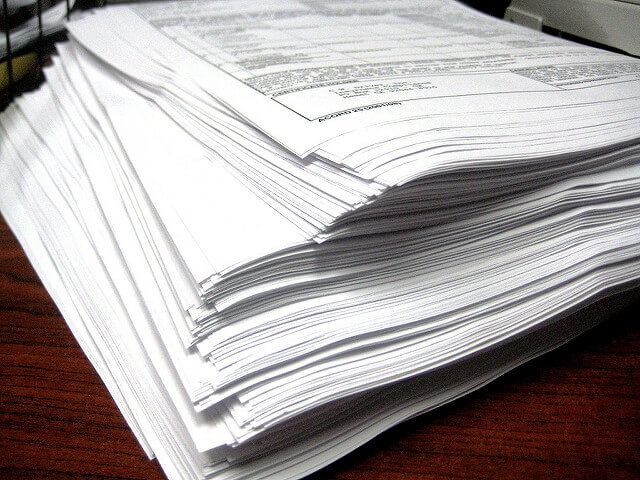
Sample Essay 1
”Most companies would agree that as the risk of physical injury occurring on the job increases, the wages paid to employees should also increase. Hence it makes financial sense for employers to make the workplace safer: they could thus reduce their payroll expenses and save money.”
Discuss how well reasoned you find this argument. In your discussion be sure to analyze the line of reasoning and the use of evidence in the argument.
For example, you may need to consider what questionable assumptions underlying the thinking and what alternative explanations or counter examples might weaken the conclusion. You can also discuss what sort of evidence would strengthen or refute the argument, what changes in the argument would make it more logically sound, and what, if anything, would help you better evaluate its conclusion.
Introduction:
This argument states that it makes financial sense for employers to make the workplace safer because lower wages could then be paid to employees. This conclusion is based on the premise that as the risk of physical injury increases, the wages paid to employees should also increase. However, this argument makes several unsupported assumptions. For example, the argument assumes that the costs associated with making the workplace safe do not outweigh the increased payroll expenses due to hazardous conditions.
Body Paragraph 1
The first issue to be addressed is whether increased labor costs justify large capital expenditures to improve the work environment. Clearly one could argue that if making the workplace safe would cost an exorbitant amount of money in comparison to leaving the workplace as is and paying slightly increased wages than it would not make sense to improve the work environment. For example, if making the workplace safe would cost $100 million versus additional payroll expenses of only $5,000 per year, it would make financial sense to simply pay the increased wages. No business or business owner would pay all that extra money just to save a couple dollars and improve employee health and relations. To consider this, a cost benefit analysis must be made. I also feel that although a cost benefit analysis should be the determining factor with regard to these decisions making financial sense, it may not be the determining factor with regard to making social, moral and ethical sense.
Body Paragraph 2
Finally one must understand that not all work environments can be made safer. For example, in the case of coal mining, a company only has limited ways of making the work environment safe. While companies may be able to ensure some safety precautions, they may not be able to provide all the safety measures necessary. In other words, a mining company has limited ability to control the air quality within a coal mine and therefore it cannot control the risk of employees getting black. In other words, regardless of the intent of the company, some jobs are simply dangerous in nature.
In conclusion, while at first it may seem to make financial sense to improve the safety of the work environment sometimes it truly does not make financial sense. Furthermore, financial sense may not be the only issue a company faces. Other types of analyses must be made such as the social ramifications of an unsafe work environment and the overall ability of a company to improve that environment (i.e., coal mine). Before any decision is made, all this things must be considered, not simply the reduction of payroll expenses.
Sample Essay 2
The following appeared in a memorandum issued by a large city’s council on the arts.
“In a recent citywide poll, fifteen percent more residents said that they watch television programs about the visual arts than was the case in a poll conducted five years ago. During these past five years, the number of people visiting our city’s art museums has increased by a similar percentage. Since the corporate funding that supports public television, where most of the visual arts programs appear, is now being threatened with severe cuts, we can expect that attendance at our city’s art museums will also start to decrease. Thus some of the city’s funds for supporting the arts should be reallocated to public television.”
Discuss how well reasoned… etc.
Introduction
In this argument the author concludes that the city should allocate some of its arts funding to public television. The conclusion is based on two facts: (1) attendance at the city’s art museum has increased proportionally with the increases in visual-arts program viewing on public television, and (2) public television is being threatened by severe cuts in corporate funding. While this argument is somewhat convincing, a few concerns need to be addressed.
To begin with, the argument depends on the assumption that increased exposure to the visual arts on television, mainly public television, has caused a similar increase in local art-museum attendance. However, just because increased art-museum attendance can be statistically correlated with similar increases in television viewing of visual-arts programs, this does not necessarily mean that the increased television viewing of arts is the cause of the rise in museum attendance.
Moreover, perhaps there are other factors relevant to increased interest in the local art museum; for instance, maybe a new director had procured more interesting, exciting acquisitions and exhibits during the period when museum attendance increased, in addition, the author could be overlooking a common cause of both increases. It is possible that some larger social or cultural phenomenon is responsible for greater public interest in both television arts programming and municipal art museums.
Body Paragraph 3
To be fair, however, we must recognize that the author’s assumption is a special case of a more general one that television viewing affects people’s attitudes and behavior. Common sense and observation tell me that this is indeed the case. After all, advertisers spend billions of dollars on television ad time because they trust this assumption as well.
In conclusion, I am somewhat persuaded by this author’s line of reasoning. The argument would be strengthened if the author were to consider and rule out other significant factors that might have caused the increase in visits to the local art museum.
Sample Essay 3
The following appeared in a report presented for discussion at a meeting of the directors of a company that manufactures parts for heavy machinery.
“The falling revenues that the company is experiencing coincide with delays in manufacturing. These delays, in turn, are due in large part to poor planning in purchasing metals. Consider further that the manager of the department that handles purchasing of raw materials has an excellent background in general business, psychology, and sociology, but knows little about the properties of metals. The company should, therefore, move the purchasing manager to the sales department and bring in a scientist from the research division to be manager of the purchasing department.”
In response to a coincidence between falling revenues and delays in manufacturing, the report recommends replacing the manager of the purchasing department. The grounds for this action are twofold. First, the delays are traced to poor planning in purchasing metals. Second, the purchasing manager’s lack of knowledge of the properties of metals is thought to be the cause of the poor planning. It is further recommended that the position of the purchasing manager be filled by a scientist from the research division and that the current purchasing manager be reassigned to the sales department. In support of this latter recommendation, the report states that the current purchasing manager’s background in general business, psychology, and sociology equip him for this new assignment. The recommendations advanced in the report are questionable for two reasons.
To begin with, the report fails to establish a causal connection between the falling revenues of the company and the delays in manufacturing. The mere fact that falling revenues coincide with delays in manufacturing is insufficient to conclude that the delays caused the decline in revenue. Without compelling evidence to support the causal connection between these two events, the report’s recommendations are not worthy of consideration.
Second, a central assumption of the report is that knowledge of the properties of metals is necessary for planning in purchasing metals. No evidence is stated in the report to support this crucial assumption. Moreover, it is not obvious that such knowledge would be required to perform this task. Since planning is essentially a logistical function, it is doubtful that in-depth knowledge of the properties of metals would be helpful in accomplishing this task.
In conclusion, this is a weak argument. To strengthen the recommendation that the manager of the purchasing department be replaced, the author would have to demonstrate that the falling revenues were a result of the delays in manufacturing. Additionally, the author would have to show that knowledge of the properties of metals is a prerequisite for planning in purchasing metals.
Sample Essay 4
The following appeared in an announcement issued by the publisher of The Mercury, a weekly newspaper.
“Since a competing lower-priced newspaper, The Bugle, was started five years ago, The Mercury’s circulation has declined by 10,000 readers. The best way to get more people to read The Mercury is to reduce its price below that of The Bugle, at least until circulation increases to former levels. The increased circulation of The Mercury will attract more businesses to buy advertising space in the paper.”
A newspaper publisher is recommending that the price of its paper, The Mercury, be reduced below the price of a competing newspaper, The Bugle. This recommendation responds to a severe decline in circulation of The Mercury during the 5-year period following the introduction of The Bugle. The publisher’s line of reasoning is that lowering the price of The Mercury will increase its readership, thereby increasing profits because a wider readership attracts more advertisers. This line of reasoning is problematic in two critical respects.
While it is clear that increased circulation would make the paper more attractive to potential advertisers, it is not obvious that lowering the subscription price is the most effective way to gain new readers. The publisher assumes that price is the only factor that caused the decline in readership. But no evidence is given to support this claim. Moreover, given that The Mercury was the established local paper, it is unlikely that such a mass exodus of its readers would be explained by subscription price alone.
There are many other factors that might account for a decline in The Mercury’s popularity. For instance, readers might be displeased with the extent and accuracy of its news reporting, or the balance of local to other news coverage. Moreover, it is possible The Mercury has recently changed editors, giving the paper a locally unpopular political perspective. Or perhaps readers are unhappy with the paper’s format, the timeliness of its feature articles, its comics or advice columns, the extent and accuracy of its local event calendar, or its rate of errors.
In conclusion, this argument is weak because it depends on an oversimplified assumption about the causal connection between the price of the paper and its popularity. To strengthen the argument, the author must identify and explore relevant factors beyond cost before concluding that lowering subscription prices will increase circulation and, thereby, increase advertising revenues.
Sample Essay 5
The following appeared as part of an article in a magazine devoted to regional life.
“Corporations should look to the city of Helios when seeking new business opportunities or a new location. Even in the recent recession, Helios’s unemployment rate was lower than the regional average. It is the industrial center of the region, and historically it has provided more than its share of the region’s manufacturing jobs. In addition, Helios is attempting to expand its economic base by attracting companies that focus on research and development of innovative technologies.”
In this argument corporations are urged to consider the city of Helios when seeking a new location or new business opportunities. To support this recommendation, the author points out that Helios is the industrial center of the region, providing most of the region’s manufacturing jobs and enjoying a lower-than-average unemployment rate. Moreover, it is argued, efforts are currently underway to expand the economic base of the city by attracting companies that focus on research and development of innovative technologies. This argument is problematic for two reasons.
To begin with, it is questionable whether the available labor pool in Helios could support all types of corporations. Given that Helios has attracted mainly industrial and manufacturing companies in the past, it is unlikely that the local pool of prospective employees would be suitable for corporations of other types. For example, the needs of research and development companies would not be met by a labor force trained in manufacturing skills. For this reason, it’s unlikely that Helios will be successful in its attempt to attract companies that focus or research and development of innovative technologies.
Another problem with the available work force is its size. Due to the lower than average unemployment rate in Helios, corporations that require large numbers of workers would not find Helios attractive. The fact that few persons are out of work suggests that new corporations will have to either attract new workers to Helios or pay the existing workers higher wages in order to lure them away from their current jobs. Neither of these alternatives seems enticing to companies seeking to relocate.
In conclusion, the author has not succeeded in providing compelling reasons for selecting Helios as the site for a company wishing to relocate. In fact, the reasons offered function better as reasons for not relocating to Helios. Nor has the author provided compelling reasons for companies seeking new business opportunities to choose Helios.
Sample Essay 6
The following appeared in the health section of a magazine on trends and lifestyles.
“People who use the artificial sweetener aspartame are better off consuming sugar, since aspartame can actually contribute to weight gain rather than weight loss. For example, high levels of aspartame have been shown to trigger a craving for food bydepleting the brain of a chemical that registers satiety, or the sense of being full. Furthermore, studies suggest that sugars, if consumed after at least 45 minutes of continuous exercise, actually enhance the body’s ability to burn fat. Consequently, those who drink aspartame-sweetened juices after exercise will also lose this calorie-burning benefit. Thus it appears that people consuming aspartame rather than sugar are unlikely to achieve their dietary goals.”
In this argument the author concludes that people trying to lose weight are better off consuming sugar than the artificial sweetener aspartame. To support this conclusion the author argues that aspartame can cause weight gain by triggering food cravings, whereas sugar actually enhances the body’s ability to burn fat. Neither of these reasons provides sufficient support for the conclusion.
The first reason that aspartame encourages food cravings is supported by research findings that high levels of aspartame deplete the brain chemical responsible for registering a sense of being satedHidden text (sated, sating ), or full. But the author’s generalization based on this research is unreliable. The research was based on a sample in which large amounts of aspartame were administered; however, the author applies the research findings to a target population that includes all aspartame users, many of whom would probably not consume high levels of the artificial sweetener.
The second reason that sugar enhances the body’s ability to burn fat is based on the studies in which experimental groups, whose members consumed sugar after at least 45 minutes of continuous exercise, showed increased rates of fat burning. The author’s general claim, however, applies to all dieters who use sugar instead of aspartame, not just to those who use sugar after long periods of exercise. Once again, the author’s generalization is unreliable because it is based on a sample that clearly does not represent all dieters.
To conclude, each of the studies cited by the author bases its findings on evidence that does not represent dieters in general; for this reason, neither premise of this argument is a reliable generalization. Consequently, I am not convinced that dieters are better off consuming sugar instead of aspartame.
Sample Essay 7
The following appeared in the editorial section of a corporate newsletter.
“The common notion that workers are generally apathetic about management issues is false, or at least outdated: a recently published survey indicates that 79 percent of the nearly 1,200 workers who responded to survey questionnaires expressed a high level of interest in the topics of corporate restructuring and redesign of benefits programs.”
Based upon a survey among workers that indicates a high level of interest in the topics of corporate restructuring and redesign of benefits programs, the author concludes that workers are not apathetic about management issues. Specifically, it is argued that since 79 percent of the 1200 workers who responded to survey expressed interest in these topics, the notion that workers are apathetic about management issues is incorrect. The reasoning in this argument is problematic in several respects.
First, the statistics cited in the editorial may be misleading because the total number of workers employed by the corporation is not specified. For example, if the corporation employs 2000 workers, the fact that 79 percent of the nearly 1200 respondents showed interest in these topics provides strong support for the conclusion. On the other hand, if the corporation employs 200,000 workers, the conclusion is much weaker.
Another problem with the argument is that the respondents’ views are not necessarily representative of the views of the work force in general. For example, because the survey has to do with apathy, it makes sense that only less apathetic workers would respond to it, thereby distorting the overall picture of apathy among the work force. Without knowing how the survey was conducted, it is impossible to assess whether or not this is the case.
A third problem with the argument is that it makes a hasty generalization about the types of issues workers are interested in. It accords with common sense that workers would be interested in corporate restructuring and redesign of benefits programs, since these issues affect workers very directly. However, it is unfair to assume that workers would be similarly interested in other management issues—ones that do not affect them or affect them less directly.
In conclusion, this argument is not convincing as it stands. To strengthen it, the author would have to show that the respondents account for a significant and representative portion of all workers. Additionally, the author must provide evidence of workers’ interest other management topics—not just those that affect workers directly.
Sample Essay 8
The following appeared in the opinion column of a financial magazine.
“On average, middle-aged consumers devote 39 percent of their retail expenditure to department store products and services, while for younger consumers the average is only 25 percent. Since the number of middle-aged people will increase dramatically within the next decade, department stores can expect retail sales to increase significantly during that period. Furthermore, to take advantage of the trend, these stores should begin to replace some of those products intended to attract the younger consumer with products intended to attract the middle-aged consumer.”
Based on an expected increase in the number of middle-aged people during the next decade, the author predicts that retail sales at department stores will increase significantly over the next ten years. To bolster this prediction, the author cites statistics showing that middle-aged people devote a much higher percentage of their retail expenditure to department-store services and products than younger consumers do. Since the number of middle-aged consumers is on the rise and since they spend more than younger people on department-store goods and services, the author further recommends that department stores begin to adjust their inventories to capitalize on this trend. Specifically, it is recommended that department stores increase their inventory of products aimed at middle- aged consumers and decrease their inventory of products aimed at younger consumers. This argument is problematic for two reasons.
First, an increase in the number of middle-aged people does not necessarily portend an overall increase in department-store sales. It does so only on the assumption that other population groups will remain relatively constant. For example, if the expected increase in the number of middle-aged people is offset by an equally significant decrease in the number of younger people, there will be little or no net gain in sales.
Second, in recommending that department stores replace products intended to attract younger consumers with products more suitable to middle-aged consumers, the author assumes that the number of younger consumers will not also increase. Since a sizable increase in the population of younger consumers could conceivably offset the difference in the retail expenditure patterns of younger and middle- aged consumers, it would be unwise to make the recommended inventory adjustment lacking evidence to support this assumption.
This argument is unacceptable. To strengthen the argument the author would have to provide evidence that the population of younger consumers will remain relatively constant over the next decade.
We hope that our strategies help you conquer GMAT AWA with enough and more energy to spare for the sections that follow!
Now that you’ve figured out how to tackle the AWA section, do you want to put theory to practice and get your AWA essay graded?
Our experts here at CrackVerbal will evaluate and grade your AWA essay and give you specific, actionable feedback.
Talk To Your Advisor
- Skip to content
GMAT Prep Courses & Tutoring
Example of a High-Scoring AWA Essay
Sample awa prompt (fern valley university).
The following appeared as part of a recommendation from the financial planning office to the administration of Fern Valley University.
"In the past few years, Fern Valley University has suffered from a decline in both enrollments and admissions applications. The reason can be discovered from our students, who most often cite poor teaching and inadequate library resources as their chief sources of dissatisfaction with Fern Valley. Therefore, in order to increase the number of students attending our university, and hence to regain our position as the most prestigious university in the greater Fern Valley metropolitan area, it is necessary to initiate a fund-raising campaign among the alumni that will enable us to expand the range of subjects we teach and to increase the size of our library facilities."
Discuss how well reasoned you find this argument. In your discussion, be sure to analyze the line of reasoning and the use of evidence in the argument. For example, you may need to consider what questionable assumptions underlie the thinking and what alternative explanations or counterexamples might weaken the conclusion. You can also discuss what sort of evidence would strengthen or refute the argument, what changes in the argument would make it more logically sound, and what, if anything, would help you better evaluate its conclusion.
Understand the argument
The financial planning office of Fern Valley University recommends that the university raise funds from among the alumni to expand the range of subjects taught at the university and increase the size of library facilities, all to increase the number of students attending the university and improve its reputation. This recommendation is in response to the fact that there has been a decline in enrollments and admissions applications at Fern Valley University for the last few years. The department feels that the reason for this decline is that some students have been dissatisfied with the quality of teaching and library facilities at the school.
Faulty assumptions
- Poor teaching is connected to the range of subjects taught
- The students citing these reasons are representative of the other students in general
- No other factor has contributed significantly to the decline in enrollments or admissions applications
- No other factor is significantly responsible for the dissatisfaction expressed by students
Missing evidence
- Proof that the quality of teaching is directly related to the range of subjects taught
- Data on the students who cited the mentioned reasons
- Details about other possible factors that can affect enrollments or admissions applications
- Specifics about other factors that can cause dissatisfaction in students
Counter-examples
- What if quality of teaching is not significantly affected by the range of subjects but by some other factor?
- What if only a small portion of students are dissatisfied with the quality of teaching and library facilities while the majority are quite satisfied with these things?
- What if some other factor has led to the decline in enrollments and admissions applications?
- What if some other factor has caused dissatisfaction in students?
Sample high-scoring essay
The financial planning office of Fern Valley University suggests that a fundraising campaign be initiated in order to increase the range of subjects taught at the university and to expand library facilities. The goal is mainly to halt the declining number of students and admissions by addressing these two issues. While the suggestion seems valid initially, a deeper investigation reveals that key facts are missing and important questions are unanswered, leaving the claim dubious.
To begin with, the department recommends that to remedy the declining number of students, the university should expand the range of subjects and improve library facilities. While both tasks are important and admirable goals in general, the department's reason for these goals is that students expressed dissatisfaction with the teaching and library facilities. Two questions beg to be answered before this suggestion can be evaluated. Are the students who cite dissatisfaction representative of all the students in general? If they are not, this move will not necessarily help to increase the number of students because it would appear that some other factor is responsible for the declining number. The second question that comes to mind is that even if the students are representative of all Fern Valley University students in general, how exactly is poor teaching connected to the range of subjects? If poor teaching is indeed the reason for the dissatisfaction and ultimately for the declining number of students, then the resolution would be to improve the quality of teaching, possibly by improving the curriculum, the manner in which it is taught, and the training of the teachers. Simply expanding the range of subjects taught will not affect the quality of teaching.
Aside from addressing the assumptions made, the department should determine all the possible factors that might have resulted in the declining number of students and admissions, factors such as more and better universities, negative feedback from students, a booming job market, etc. When such factors are determined, then a proper course of measure should be charted to deal with those issues. Additionally, the department should also ascertain whether the students who express dissatisfaction speak for the majority. If they do, then measures should be taken to improve the quality of teaching and the library facilities. Finally, as a natural progression, the range of subjects should be expanded and library facilities improved after conducting a thorough survey of students and the market to determine the specifics of what subjects and what facilities would be best added.
To conclude, to simply assume that students expressing dissatisfaction is the primary reason for the declining number of students without specifically ascertaining so is illogical. Further, to use those assumptions and provide a cosmetic solution invites further trouble. Thus, the department should refrain from reactionary measures and take into account the aspects discussed above, after which the recommendation will be more well-reasoned and logical.

MBA Resources
Successful GMAT Waiver Request Letters

MBA & Beyond Team
22/08/2023 | 6:10 pm
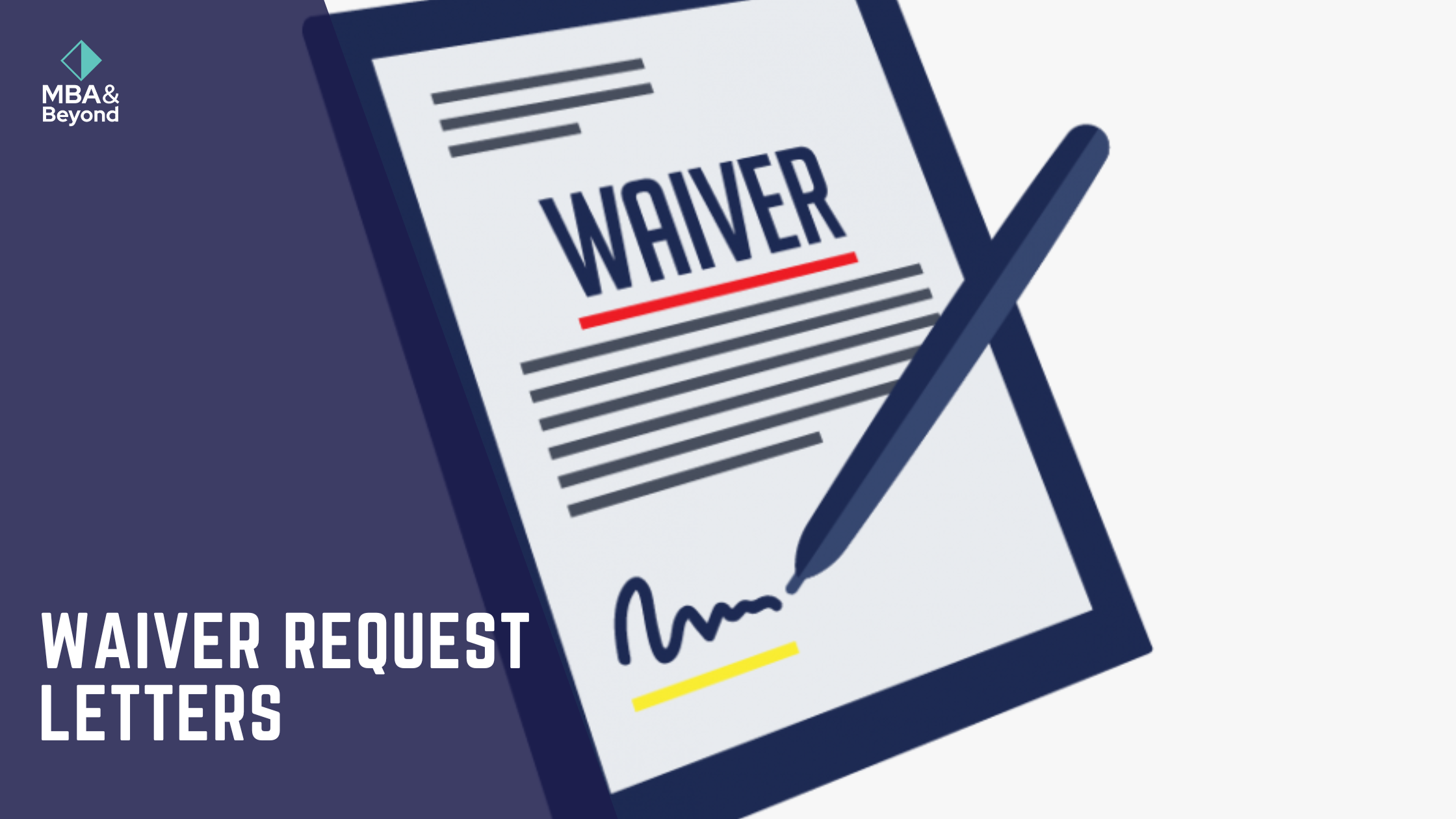
For many aspiring business leaders, an MBA is the golden ticket to a fulfilling career. These coveted programs equip graduates with a potent combination of theoretical knowledge and practical skills, opening doors to lucrative positions with significant impact. However, the traditional gateway to these programs, the GMAT, can be a significant hurdle. Here’s where successful GMAT waiver request letters come in, offering a streamlined path for qualified individuals.
Every aspiring candidate harbors the dream of studying at some of the world’s most renowned universities and colleges. However, in leading business schools, GMAT scores are deemed a crucial component of the application. For certain students, one of the most challenging aspects of the application process is getting ready for standardized tests, either due to time constraints for proper preparation or because these students struggle with test-taking.
This is where the notion of a GMAT waiver comes into play. We will furnish you with comprehensive details about the GMAT waiver and offer tips on crafting a successful GMAT waiver request letter.
Here is the Snapshot of the article:
*Note: In this article, “GMAT waiver essay” and “GMAT/GRE request letters” are one and the same and used interchangeably. Most schools do not have any essays for GMAT waivers and hence only ask for a letter to request for getting a GMAT waiver.
TALK TO ALUMS OF YOUR TARGET SCHOOL AND KNOW YOUR CHANCES!
WHAT IS A GMAT WAIVER?
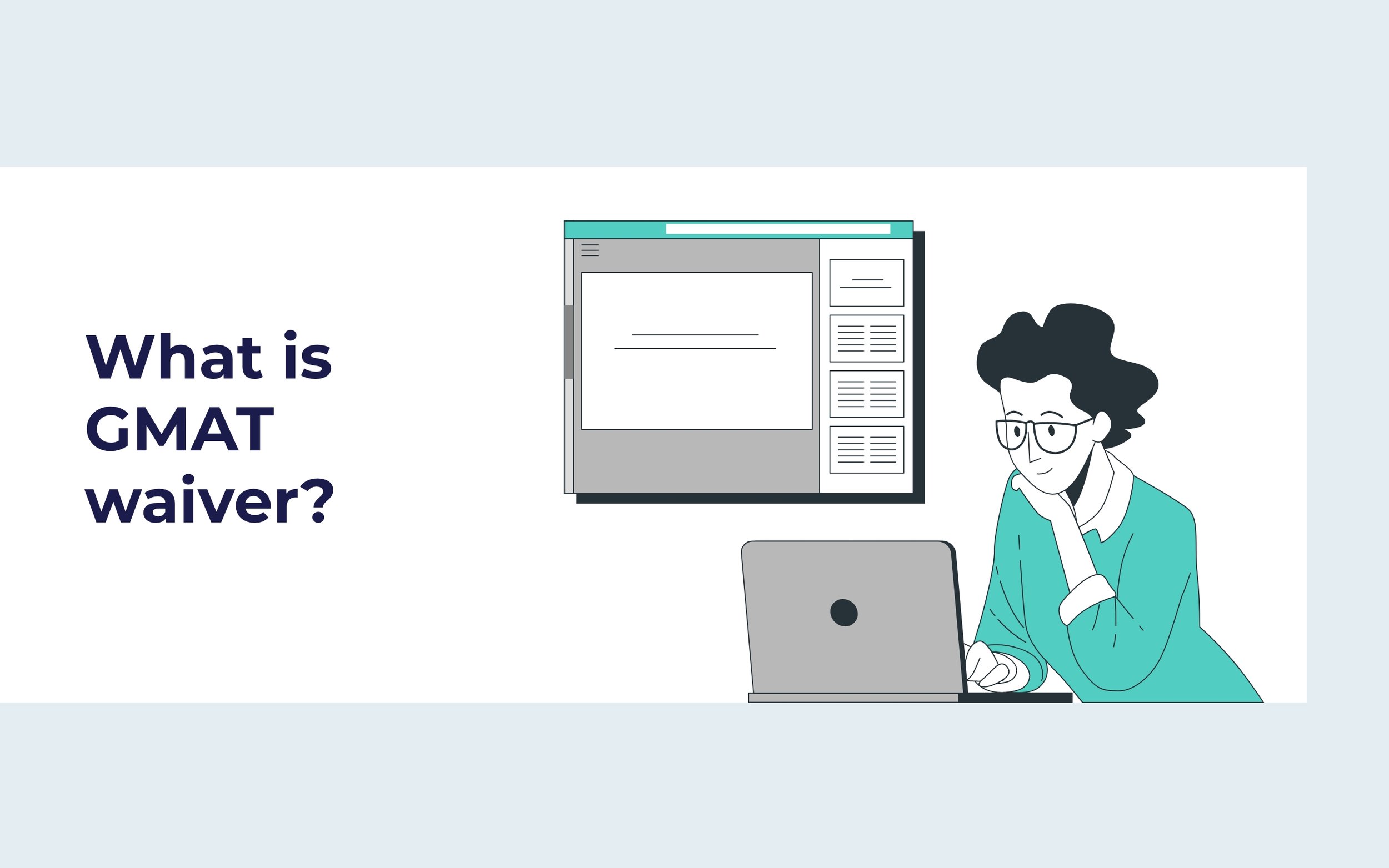
Briefly, a GMAT waiver enables an MBA program applicant to skip submitting a test score, especially if they meet specific criteria related to work experience, degrees, academic history, or other specified conditions.
Schools grant GMAT/GRE exemptions at the discretion of admission officers, who assess each GMAT/GRE waiver request letter or GMAT waiver MBA essay. Nevertheless, certain institutions automatically provide waivers to qualifying individuals without requiring an additional GMAT/GRE waiver request letter.
Universities like Syracuse University, UNC (University of North Carolina), and GW (George Washington University) automatically extend GMAT waivers to applicants with over five years of work experience. Conversely, NJIT (New Jersey Institute of Technology) exempts GMAT requirements for individuals holding an advanced degree.
Successful GMAT Waiver Request Letters: Who Should Consider Applying?
You may be contemplating whether to submit a GMAT/GRE waiver letter. There are factors to consider if you choose to apply. If you are confident in demonstrating your abilities adequately through the exam, have met the eligibility criteria but are facing challenges in taking the GMAT/GRE exam, you might consider composing a GMAT/GRE waiver request letter. Below, we will elaborate on the key elements of successful GMAT waiver request letters.
However, if you can attain a score higher than the average for your target program and meet the eligibility criteria, it is advisable not to consider a waiver. This can bolster the strength of your candidacy, so we recommend proceeding and submitting your scores.
Yet, if you lack adequate work experience, leadership skills, a strong academic record, quantitative coursework, or if your application is weak, seeking a GMAT/GRE waiver may not be a strategic choice. The likelihood of your GMAT/GRE waiver letter getting approved is minimal, as admissions committees seek students capable of handling the school’s challenging academic program and contributing positively to their community. So, we advise you to pull up your socks and start preparing early so that you do not regret it at the end of the deadline.
START YOUR PREPARATION NOW WITH US!
Want to pursue an MBA but not sure if your profile fits?
Talk to our Profile Experts to know your chances for a top MBA Program.
MAJOR CONSTITUENTS OF SUCCESSFUL GMAT WAIVER REQUEST LETTERS

Skip the GMAT, Focus on Strengths: Admissions committees value real-world experience (career, achievements) and past academic performance over test scores. Highlight these strengths to secure a GMAT waiver.
Schools are assigning increased importance to prior coursework, work experience, and professional certifications to choose the most highly qualified applicants from the same limited pool.
See what experts have to say about the impact of your GMAT/GRE letters.
Below Paragraph deals with all the major constituents that are included in successful GMAT waiver request letters.

WORK EXPERIENCE: IMPORTANT FACTOR TO A GOOD GMAT WAIVER MBA ESSAY
Work experience constitutes the primary reason why B-schools offer test score waivers to applicants. “A real-world experience that an applicant would bring to a program is likely to be more valuable than scoring over a certain number on a test.”
FREE CONSULTATION FOR GMAT WAIVER ESSAY AND GMAT FOCUS EDITION WITH TOP B-SCHOOL ALUMS
Business schools acknowledge the additional workload and pressure that entrance exams impose on experienced working professionals. Consequently, an increasing number of schools are simplifying the application process by granting GMAT waivers. While some B-schools adhere to a broad interpretation, many of the top institutions define “relevant work experience” according to their own criteria.
While some consider management responsibilities, Strategic directions, Problem-solving, time management, personal accountability, and decision-making as key factors, many define work experience in a much broader aspect. ‘ The Work experience needs to be of a specific caliber that is relevant to the applicant’s career goals, with the average number of years of work experience required to be more than five years . However, the highest-ranked B- schools exhibit an average to be at least seven years.
Hence, work experience will become an important constituent to creating successful GMAT waiver request letters and a key solution to how to get GMAT waived.
- ACADEMIC HISTORY & ACHIEVEMENTS
Another factor influencing the evaluation of successful GMAT waiver request letters is your academic performance. Each school has varying academic preferences, encompassing undergraduate performance, additional coursework, certifications, and even advanced-level degrees. Several top B-schools set a minimum GPA threshold, typically ranging from 3.0 to 3.4, when considering waiver requests.
Learn how important your GPA for Top MBA Programs is.
Universities, such as Pepperdine University, even require that students have degrees in quantitative economics or science, engineering, technology, or mathematics disciplines for evaluating the successful GMAT waiver request letters.
- PROFESSIONAL CERTIFICATIONS- MAJOR REQUIREMENT TO GET GMAT WAIVED
Professional certifications such as Certified Public Accountant (CPA), Certified Financial Analyst (CFA), and similar licenses are taken into consideration by many B-schools when awarding waivers.
- LEADERSHIP EXPERIENCE
If your work experience showcases qualities indicative of leadership, it would be advantageous to highlight this experience in your GMAT waiver letter. Schools seek students who can tackle challenges not only for themselves but also for their team and the community, motivating everyone to strive towards becoming better versions of themselves. We suggest you back up your remarkable efforts by learning how to maximize the strength of your recommendations from senior management and colleagues, who can witness your leadership skills and professional integrity in the face of problems.
Learn how to exhibit leadership experience in your MBA application.
- PROBLEM-SOLVING SKILLS
GMAT tests are crafted to highlight problem-solving skills in comprehending various issues. The Analytical Writing Assessment (AWA), Integrated Reasoning (IR), and particularly the quantitative sections assess applicants’ performance in specific scenarios. Choosing a GMAT waiver presents an excellent opportunity to exhibit your problem-solving skills, drawing from your experience in your GMAT waiver letter.
KNOW THE DETAILS THAT YOUR APPLICATION REQUIRES TO MAKE A STRONG IMPACT
WHEN SHOULD I APPLY FOR A TEST WAIVER?
There are two types of schools in this scenario. The first category of school requires you to submit your GMAT waiver letter before your application. If the GMAT waiver is not granted, then you must take the exam before completing your application. The second category incorporates the GMAT waiver request within its application. This means that if you are applying for a GMAT waiver, you need to submit your full application before determining whether or not you still need to take the test. We recommend thoroughly reading the instructions of your chosen school and conducting comprehensive research in advance because sometimes the deadline for GMAT waiver requests is just a week ahead.
BOOK A PROFILE EVALUATION WITH STUDENTS & ALUMS OF TOP SCHOOLS! SUBMIT YOUR REQUEST AND GET THE MOST EXHAUSTIVE AND HONEST PROFILE FEEDBACK AND SUGGESTIONS FROM THE ALUMNI OF YOUR TARGET SCHOOLS!
Steps to an MBA with a GMAT Waiver Request Letter
Frequently, MBA aspirants grapple with uncertainty regarding the adequacy of their profiles and other standardized test scores to qualify for a GMAT waiver. Similarly, candidates harbor concerns that obtaining a GMAT waiver might adversely impact their chances of admission to their desired school.
1. In such a scenario, we urge MBA aspirants to follow these steps for initiating a GRE/GMAT waiver with any B-school.
- Understand the significance of the GMAT for your TARGET SCHOOLS and look at their criteria to get a GMAT waiver.
- Understand what qualities GMAT reflects in your application and how you can exhibit them with other aspects of your application
- Every school has different criteria for accepting case-by-case waivers; ensure you are well-versed with them!
2. PROFESSIONAL EXPERIENCE
- It should be your biggest strength for applying to MBA programs that don’t require GMAT.
- Professional experience is the best way to showcase your decision-making, analytical, and quantitative skills through practical examples.
- Build a compelling case for career progression that highlights your professional growth and exemplary leadership instances.
3. Bring DIVERSITY to your application.
For anyone applying with a GMAT waiver for the 2024 intake, diversity is one of the most important aspects of your application!
Emphasize the diversity of perception, thought, and perspective, underscoring how your unique contributions will enrich the MBA communities of your target school. This will make a compelling statement in front of the Adcoms.
4. Draft a unique & Stellar GMAT WAIVER LETTER
- Comprehend the formatting requirements of the particular program to which you are applying for a GMAT waiver by reviewing successful examples of GMAT waiver letters used by others.
- Open with a Clear Statement to Highlight the Letter’s Purpose!
- Demonstrate relevant skills acquired through professional work experience without the necessity of taking a GMAT.
- Add specific examples to support your claims.
We follow a unique framework to guide applicants in exploring their work experience, leadership potential, strengths, weaknesses, etc., and organize all their essays, including GMAT waivers, in a manner that can create the desired impact!
APPLYING FOR A MBA WITHOUT GMAT BASED ON CFA PROGRAM EXEMPTION
If you have a good level of achievement in the CFA Program, for example, having a specific group of the CFA Program(e.g., Level 1, Level 2) or being a charter holder, Congrats! You are eligible for a GMAT/GRE waiver and even might be eligible for an additional course waiver.
Top US MBA programs like Darden, Cornell, Duke, Emory, Dartmouth, John Hopkins, and many more offer exclusive exemptions for candidates who have cleared a specific level of the esteemed CFA exam to acknowledge their achievements by providing course waivers and other benefits! For detailed information on top MBA programs offering GMAT waivers for the MBA 2024 intake based on CFA program exemption, refer to our article titled “MBA GMAT Waiver 2024: CFA Exemptions.”
APPLYING FOR AN MBA WITHOUT GMAT AS AN ARMY VETERAN
Numerous top B-schools highly appreciate the leadership and decision-making skills cultivated during military service. In recognition of their commitment to the country, these institutions extend a GMAT waiver to all eligible candidates with a military background. Furthermore, these B-schools also grant a waiver for candidates with an army background to underscore the significance of diversity. The aim is to include students from varied backgrounds and experiences, enhancing the richness of content in classroom discussions and learning.
Below are some veteran-friendly programs that value their military experience and support them with a GMAT waiver for their military background. These MBA Programs Without GMAT Requirements are-

ARE GMAT SCORES IMPORTANT?
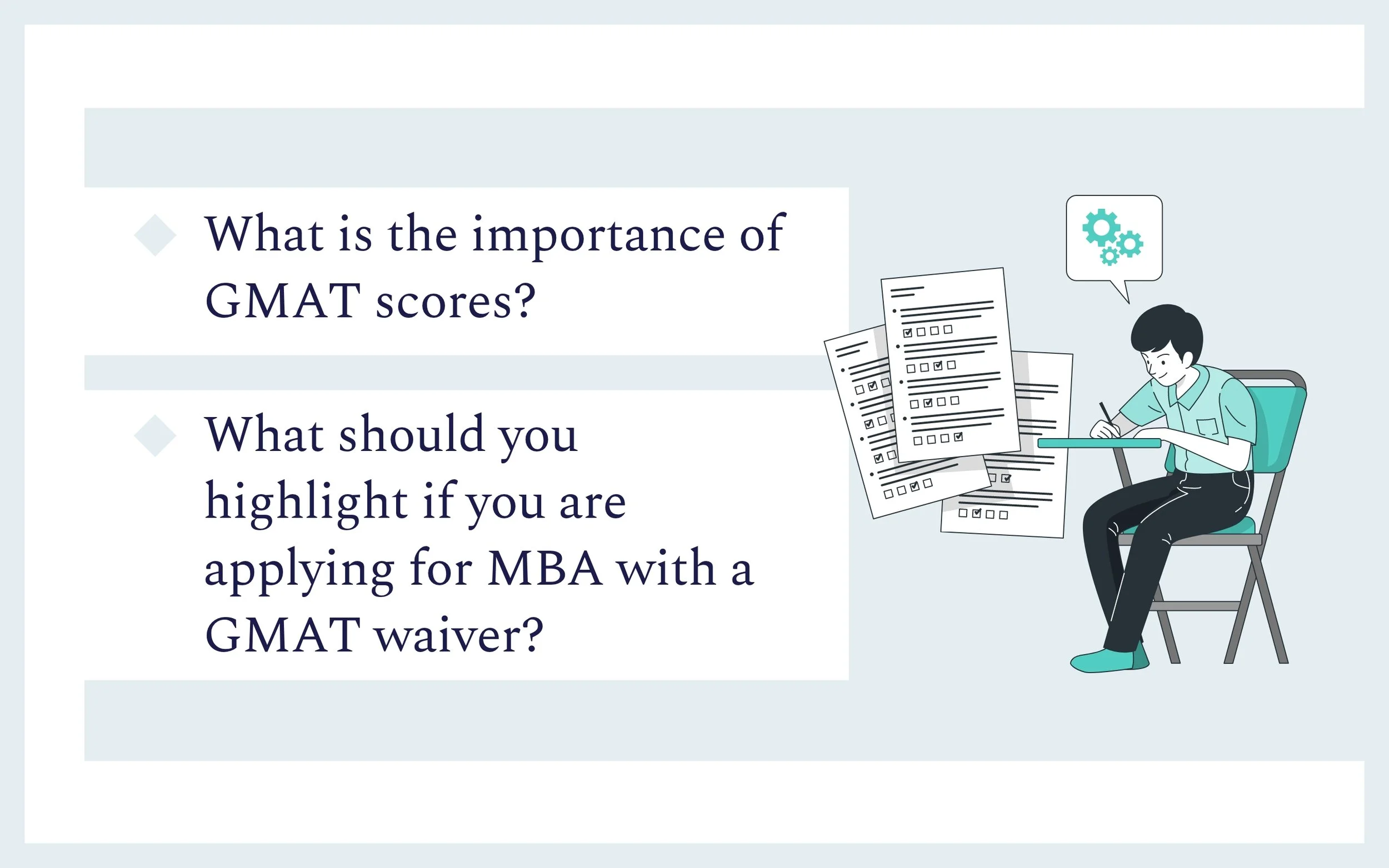
While the GMAT adds significant value to your candidacy, there is a growing trend among business schools to waive entrance exams and admit students who do not submit GMAT or GRE scores, even at highly ranked programs.
If applicants meet one or more of the GMAT waiver eligibility criteria, they are exempted from providing their GMAT scores as part of the application process. This approach was adopted to address the concern that numerous high-potential applicants with extensive work experience were either hesitant or limiting their application to MBA programs due to lower GMAT scores.
Among top B-schools, which include the University of North Carolina, the University of Delaware, George Washington University, NJIT, and Syracuse University, most admitted students did not provide GMAT or GRE scores with their applications; only less than three percent of admitted students provided scores.
However, for the Top 25 MBA programs, a strong GMAT score remains a crucial requirement. Even if you are submitting a GMAT/GRE waiver request letter (assuming the school is waiving the GMAT requirement and you qualify for it), you must present exceptionally strong essays and an overall compelling application.
Know how you can make a strong application if you are applying with a GMAT waiver.
Successful GMAT Waiver Request Letters: Finding Your Perfect Fit
Check with specific institutions for criteria to be eligible for a GMAT waiver. MBA program applicants should confirm their alignment with eligibility guidelines before submitting a GMAT waiver request letter. Each program establishes the specific eligibility requirements they wish to apply.
If you qualify for the requirements, you can submit a GMAT waiver request letter.
However, there is another aspect to consider. If you are aiming for M7 or T10 schools with a waiver, you must possess a strong quantitative background, substantial achievements, a promising career trajectory, and a compelling narrative to present in your MBA application.
TOP B-SCHOOLS WAIVING AND ITS CRITERIA: BASIC CRITERIA FOR GMAT WAIVER.
These are some general points you must have before submitting the GMAT waiver request letter:
- Ten years of professional working experience
- Exceptionally high GPA scores and academic records
- An Advanced master’s degree or a recognized certification in any alternative field.
- Three recommendation letters
- Copies of transcripts from both undergraduate and graduate schools.
- A formal GMAT waiver request letter that conforms to all the parameters of the school.
The below table enlists the Top notch B-schools providing GMAT waivers for deserving candidates. Carefully go through the eligibility criteria for each of them before applying.
Note – Check B-Schools page for latest eligibility criteria
TOP MBA PROGRAMS OFFERING A GMAT WAIVER:
Gmat fee reduction program/ waiver.
Some applicants might find both concepts confusing, but these are two distinct waivers. The GMAT waiver exempts the applicant from taking the GMAT test, while the GMAT fee waiver reduces the costs associated with a GMAT exam. GMAC doesn’t directly offer GMAT fee waivers to applicants. Instead, they recommend that schools grant GMAT fee waivers only to students facing financial difficulties. Business schools that submit a request to GMAC receive up to 10 fee waivers per year. GMAC provides a code to the school, which the school uses based on the needs of the applicants.
HOW TO WRITE SUCCESSFUL GMAT WAIVER REQUEST LETTERS: GENERAL TIPS
- Conduct thorough research. Familiarize yourself with all eligibility criteria and other guidelines. Keep in mind that not every school providing a GMAT waiver will have identical criteria.
- Stay concentrated and address particular aspects that showcase quantitative and analytical skills for the successful processing and evaluation of information.
- Clear & Concise style of Writing.
- Instead of exaggerating, concentrate on two or three of the most crucial skills and emphasize them significantly.
- Revising & Proofreading
HOW TO ASK FOR A GMAT WAIVER/HOW TO WRITE A GMAT WAIVER ESSAY- GMAT/GRE WAIVER REQUEST LETTER SAMPLE
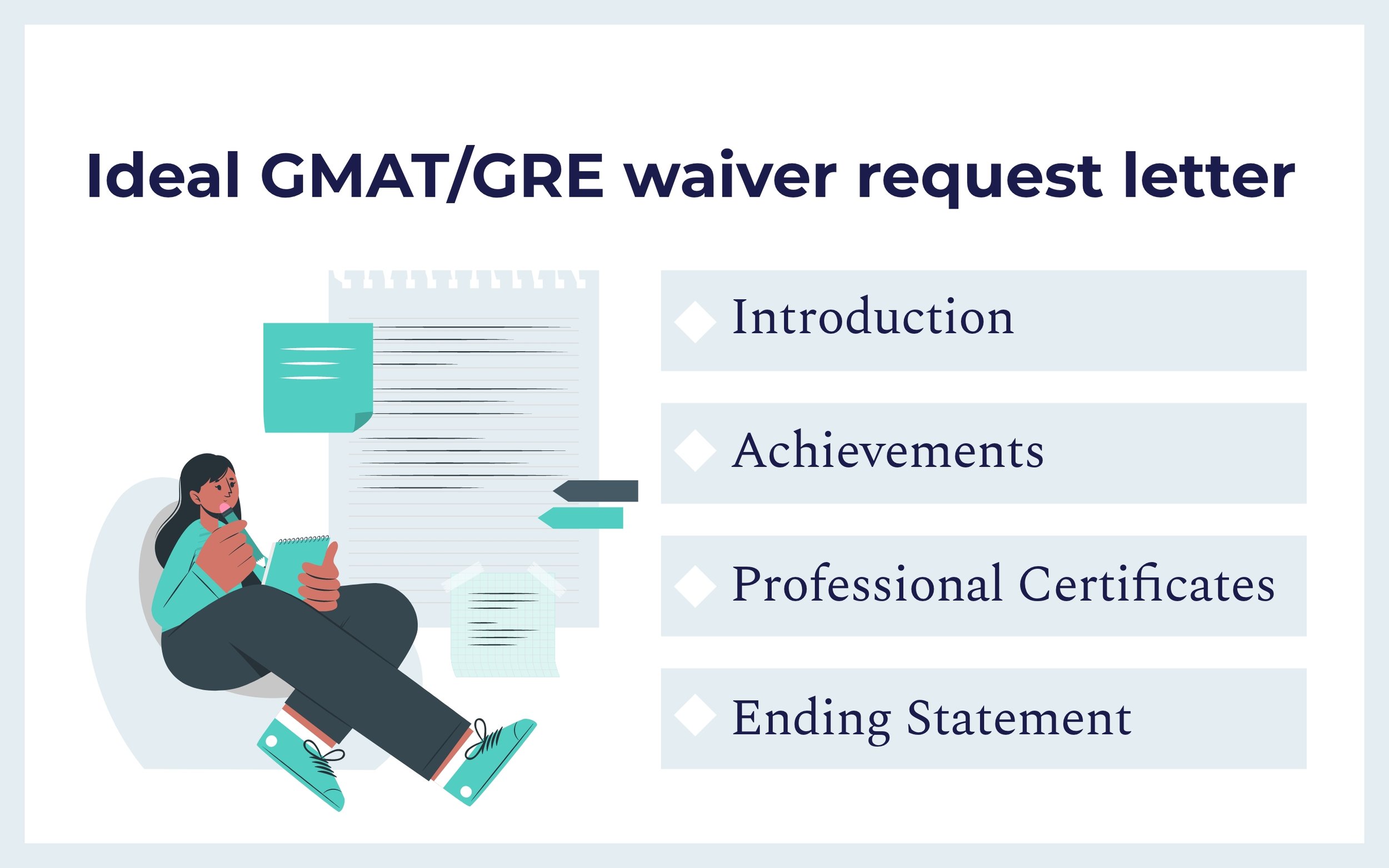
University name:-
University Address:-
Salutation- Sir or Madam
1st Paragraph: About Yourself
Introduce yourself and provide a concise overview of the specific criteria that make you eligible to submit the GMAT/GRE waiver request letter. Explain the purpose of your letter, detailing why you are writing and specifying the nature of your request.
2nd Paragraph
Expand upon your academic and professional achievements while avoiding exaggeration. Overstating your qualifications may be perceived as bragging. Ensure that each accomplishment, no matter how significant, contributes to the purpose of convincing admissions; otherwise, it shouldn’t be included.
3rd Paragraph
Offer valid certificates and awards as evidence. Highlight your achievements that align with their requirements, aiding in your quest for a GMAT waiver. Ensure to delve into specific aspects of your professional work experience that align with the skills the GMAT is designed to assess. This will bolster your argument for applying for a waiver.
4th Paragraph:
Ending statement. Thank the reader for taking the time to read your letter. Make it as well polished as you can.
Contact details.
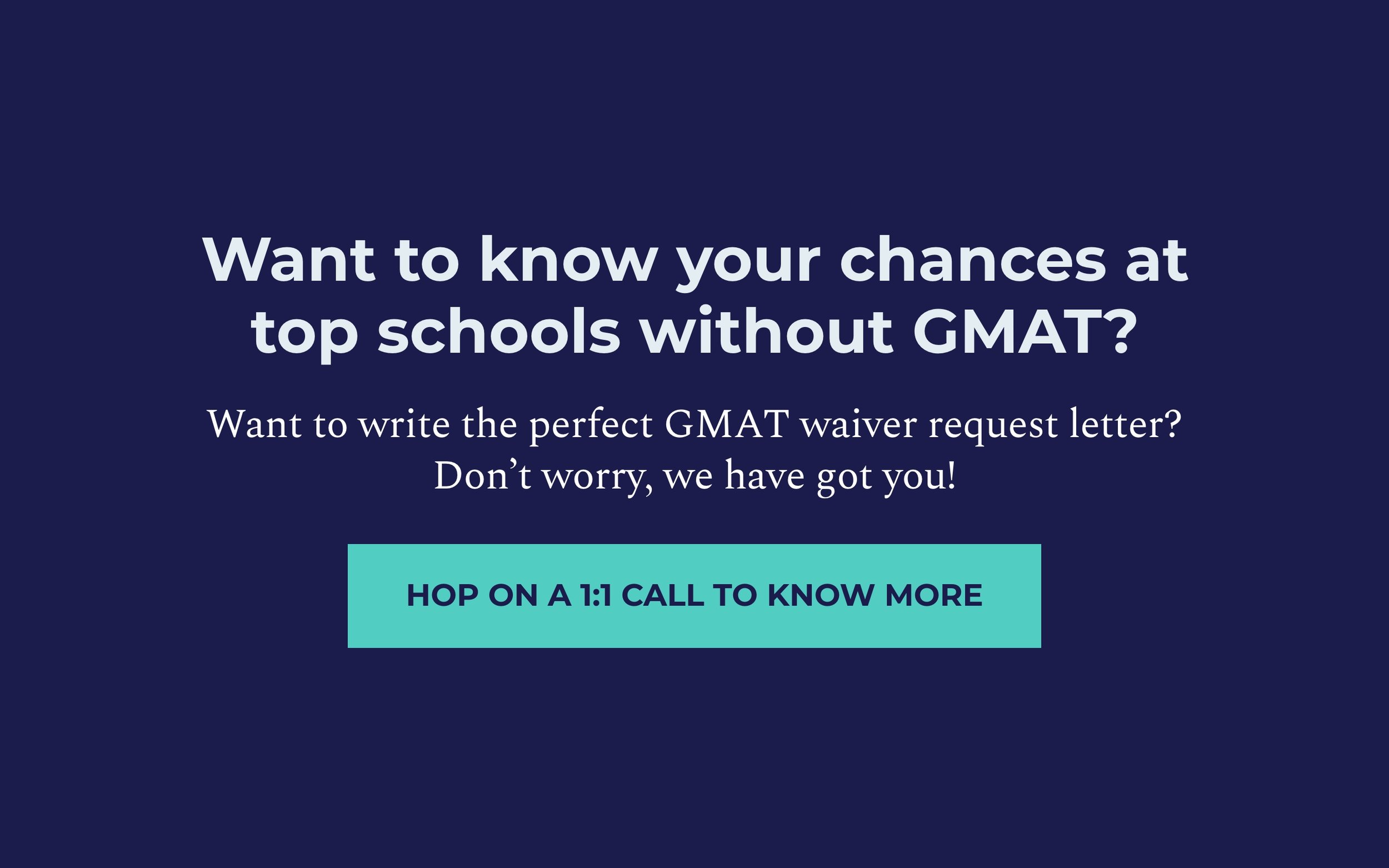
This is it from our side; we know it’s quite long. But we hope you got some great insights about the GMAT waiver request letter. If you require an expert to give your application or essay the light that can shine in the eyes of adcoms, you can count on us.
We offer a limited number of complimentary profile evaluations each week to maximize your chances. We match you with the students and alums of top B-Schools according to your background and target schools. In this call, the experts will try to dig out your USP for top B-schools and provide you with honest feedback on your profile and chances to your target schools.
Frequently Asked Questions
HOW DO I GET A GMAT WAIVER?
You need to have strong elements on your profile like work experience, academics, professional certifications, etc.
Also, you need to see the criteria for your target schools and see if you meet the requirements. If yes, you can go ahead and submit a GMAT waiver request letter (if required).
WHICH BUSINESS SCHOOLS ARE WAIVING THE GMAT?
You can see the list of business schools waiving GMAT in 2021-22 and their criteria in the table above.
IS GMAT WAIVED FOR 2022?
Yes, many schools are waiving the GMAT for 2022 intake. Some top schools include MIT, Ross, Kelley and Darden.
WHAT IS AN ACCEPTABLE GMAT SCORE?
For all the schools, there is generally no minimum limit or “acceptable GMAT score” as such. However, you may look into the class profile of your target schools to know what can be a good GMAT score to target. If you are an over-represented applicant (like Indian or Chinese), you may want to add 20+ in the average range to target a good GMAT for yourself.
Leave a Reply
Your email address will not be published. Required fields are marked *
Articles You Might Like

Should an International Candidate go for an INSEAD R3 MBA?
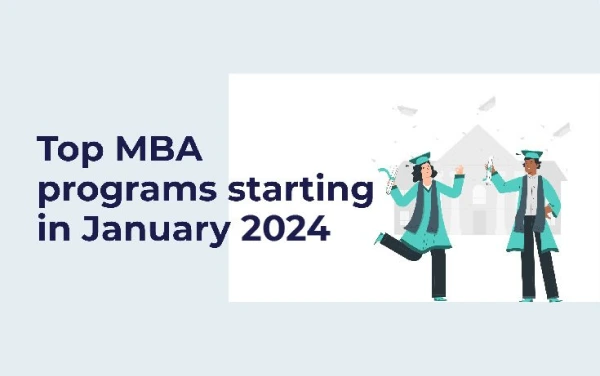
Top MBA programs starting in January 2024
Upcoming Events

Tips for Early Action Round and Round 1
June 13, 2024 | 9:00 pm – 10:00 pm
UPCOMING EVENT: Tips for Early Action Round and Round 1. Register now

Customized for You
Track Your Progress
Practice Pays
Practice thousands of GMAT questions with top expert solutions.
Identify and improve upon mistakes efficiently using our Error Log.
Get the latest tips and news from our top GMAT professionals.
- it’s free and easy!
Thank you for using the timer! We noticed you are actually not timing your practice. Click the START button first next time you use the timer. There are many benefits to timing your practice , including:
We’ll give you an estimate of your score
We’ll provide personalized question recommendations
Your score will improve and your results will be more realistic

FREE Focus Edition Mock!
The GMAT Club Podcast - GMAT Focus 99 Percentile - Speed vs Accuracy
Most Effective Reading Strategies to Master RC and Score High (Free Webinar)
Free Webinar – Achieve 90th %ile score on GMAT CR and TPA
Master GI & TPA Questions on GMAT DI (Free Webinar)
Ace Arithmetic on the GMAT Focus Edition
MBA Spotlight Fair
Prep smart with Magoosh GMAT

08:00 PM PDT
09:00 PM PDT

12:00 PM PDT
01:00 PM PDT

05:30 AM PDT
07:30 AM PDT

11:00 AM IST
01:00 PM IST

05:40 AM PDT

11:00 AM PDT
How to get 6.0 AWA on GMAT ....my guide
- List of all AWA topics from GMAC
- Sample replies to all Essays or simply search - we have thousands of sample AWA essays
- Want to get your essay evaluated? Post it in the AWA subforum
- Overview of GMAT Write, the official essay grading tool
- How to memorize this template using text to voice feature by plaverbach
1. General Structure
2. Structural Word (should be all over the essays)
- Additional support - furthermore, in addition, similarly, just as, also, as a result, moreover
- Importance - surely, truly, undoubtedly, clearly, in fact, most importantly
- Contrast - on the contrary, yet, despite, rather, instead, however, although, while
- Decide against - one cannot deny that, it could be argued that, granted, admittedly
- Ying-yang - on the one hand/on the other hand
- Concluding - therefore, in summary, consequently, hence, in conclusion, ultimately, in closing
3. Templates
4. Going from the templates to full-fledged essays
5. Final tips
- During the tutorial type in a few sentences in the mock essay window to get used to the keyboard.
- Again during the tutorial, jot down on your notebook the basic structure of your essays or the opening sentences in case you get too nervous and forget them when the clock starts ticking.
- Write as much as you can. Try to write at least 500 words per essay.
- Always have the e-rater in mind as your potential reviewer. Remember that the human rater will make every effort to grade just like the e-rater. In that sense, keep your structure and volume in mind over actual quality/content.
- Be careful of spelling mistakes. Double check words that you normally know you misspell (e.g. exercise). Try to finish 2-3 minutes before time is up so you can slowly re-read your essay for the purposes of spell checking. Do not reorganize/delete sentences/paragraphs with less than 2 min left.
- No matter how great you thought your essays went, try to stay humble and focused - remember this was just a warm-up and the real stuff hasn't started yet!
You do not have the required permissions to view the files attached to this post.
The post is bookmarked successfully

GMAT Focus Edition: the Key Changes

In November 2023, GMAT launched major updates to the GMAT exam and called the updated version The GMAT Focus Edition. However, that name won’t last much longer. Why change it again? Here’s the latest from The Graduate Management Admissions Council (GMAC): “The ‘GMAT Focus Edition’ name served as a crucial distinction between it and the previous version of the GMAT while both were in the market in late 2023 and early 2024. With only one version of the exam available, we are transitioning back to using the ‘GMAT Exam’ name from July 1, 2024 onward.”
Now that we’ve addressed the next change to expect (dropping Focus Edition from the name), let’s talk about the timing and structure changes that were introduced this fall (2023).
GMAT Timing and Structure: What Changed?
The GMAT Focus Edition introduced several important updates aimed at enhancing the test-taking experience. These changes are outlined below:
- Reduced Exam Duration: The GMAT Focus Edition has three 45-minute sections. This makes the test significantly shorter, giving test takers back an hour or so of their time.
- Streamlined Content: The GMAT Focus Edition retains the Quantitative and Verbal Reasoning sections. Quant will continue to test problem solving skills, but the Data Sufficiency question type has been moved to the new Data Insights section (more on that in just a bit). Verbal now focuses only on critical reasoning and reading comprehension. Sentence corrections have been removed. The Analytical Writing Assessment (AWA) section has also been removed. The old Integrated Reasoning section has been completely overhauled and repackaged into a new section, The Data Insights section. Data Insights is intended to measure your skills in analyzing different types of data from multiple sources.
- Flexible Testing Features: The Focus Edition does not limit user ability to bookmark questions or review questions within their currently tested section. However, the test remains question-adaptive, which means that you cannot skip questions. You must submit an answer to move on to the next question. Still, the updated test does now allow a test taker to change up to three answers as long as though changes are made within each section’s time limit. One of the most significant changes is that you can now complete the test sections in any order.
- Enhanced Reporting: The new GMAT aims for more relevance to test-takers and the business schools to which they apply. Therefore, test results will include not only the Total Score (205-805), but also a detailed breakdown of insights to help the students assess which skill areas were more challenging, and which were strongest.
What if I took the Older Version of the GMAT?
Don’t worry! GMAC supports all GMAT scores as valid for 5 years, so there will be an extended transition period from the old to the new test scores.
In the meantime, its important to keep in mind that the scores do not translate. Here’s it’s worth quoting GMAC themselves: “Because the Total Score scale and the score scale distribution have both changed, comparing total scores or section scores from the current version of the exam to the GMAT Focus Edition is not appropriate, accurate, or a meaningful comparison of performance. Scores of 600 and 605 may look similar, but they represent very different performance levels on different skills.”
Preparing for the GMAT Focus Edition
The introduction of the GMAT Focus Edition is a significant change in the business school application process. By understanding the updates and utilizing the available prep resources, aspiring graduate students can confidently navigate these changes and excel in their applications. At Magoosh, we’re ready for the changes and ready to help you you prepare. Stick with us for all the latest GMAT news and insights.

View all posts
More from Magoosh

Leave a Comment
Please leave any questions or suggestions in the comments, we try our best to respond within a few days! Your email address will not be published.
Leave a Reply Cancel reply
Your email address will not be published. Required fields are marked *
16 responses to “GMAT Focus Edition: the Key Changes”
Hello, any update on the GMAT Focus Prep?
Our GMAT Focus updates have been released–you can update your Dashboard for this in your account settings! If you can’t figure it out, message us at [email protected] and we’ll show you how to switch over to it! 😀
Happy Focus Studying!
HI, when is the anticipated release date for the focus edition prep?
It should be in the next week or two! If you have a Magoosh premium account already, please write to us at [email protected] for more details/information about this! We’d love to talk further there! 😀
What is the best way to tailer my MAgoosh GMAT prep modules for the GMAT Focus edition? Are there certain sections I should ignore / sections I should spend more time on?
Note that we’ll be be updating our product for the GMAT Focus version by the end of this month! In the meantime, know that much of the Focus’s content will be largely unchanged, so you can still study with current resources to prepare for the test! The exam will no longer have Sentence Correction questions or an AWA section though, so you won’t want to study those if you’re definitely taking the Focus version!
Hope this helps, and Happy Studying! 🙂
Hi, have you updated the product?
The GMAT Focus updates are coming very soon, most likely in the first week or two of September! 😀
Hope this helps!
still waiting…
Our GMAT Focus updates have been released–you can update your Dashboard for this in your account settings! If you can’t figure it out, message us at [email protected] and we’ll show you how to switch over to it! 😀
So do you recommend us to work on the focus version or the old version if we are starting to work on gmat right now?
Hi Aymeric,
The answer to this question really depends on when your applications are due. We only know that the GMAT Focus will be available in Q4 this year–we don’t know the specific date yet. GMAC will open registration for the Focus edition in August, so we should know by then. Depending on when the test opens and when you can schedule it, you may or may not be able to take it this year and still apply to schools this year, if you have early deadlines. If your deadlines are in 2024, you could most likely plan to take the Focus version if you think that’s the best option for you! Schools will look at both versions of the test in the same way, so that shouldn’t be a factor in your decision.
Hope this helps! Good luck to you! 😀
Does Magoosh’s online GMAT prep content already reflect the changes in the GMAT format?
We are currently working on our updates and hope to release them in full by the end of July!
Hello there. What is the latest update on this?
Hi Vignesh,
If you’re asking about our product, we’re currently working on the updates for the Focus edition, and at this moment our ETA is mid-August for their release.
Hope this helps! 😀
- Exam Prep >
- Prepare for Business School >
- Business School & Careers >
- Explore Programs >
- Connect with Schools >
- How to Apply >
- Help Center >
Every journey needs a plan. Use our Career Guide to get where you want to be.
Creating an account on mba.com will give you resources to take control of your graduate business degree journey and guide you through the steps needed to get into the best program for you.
- About the Exam
- Register for the Exam
- Plan for Exam Day
- Prep for the Exam
- About the Executive Assessment
- Register for the Executive Assessment
- Plan for Assessment Day
- Prepare for the Assessment
- NMAT by GMAC
- Shop GMAT™ Official Prep
- About GMAT™ Official Prep
- Prep Strategies
- Personalized Prep Plan
- GMAT Focus Mini Quiz
- Executive Assessment Exam Prep
- NMAT by GMAC Exam Prep
Prepare For Business School
- Business Fundamentals
- Skills Insight
Business School & Careers
- Why Business School
- Student Experience
- Business Internships
- B-School Go
- Quiz: Are You Leadership Material?
- MBA Return on Investment (ROI) Calculator
- Estimate Your Salary
- Success Stories
- Diversity and Inclusion
- Women in Business
Explore Programs
- Top Business School Programs
- Quiz: Which Post Graduate Program is Right for You?
- Quiz: Find the Best Program for Your Personality
- Business School Rankings
- Business Master's Programs
- MBA Programs
- Study Destinations
- Find Programs Near Me
- Find MBA Programs
- Find Master's Programs
- Find Executive Programs
- Find Online Programs
Connect with Schools
- About GradSelect
- Create a GradSelect Profile
- Prep Yourself for B-School
- Quiz: Can You Network Like An MBA?
- Events Calendar
- School Events
- GMAC Tours Events
- In-Person Events
- Online Events
How to Apply
- Apply to Programs
- The Value of Assessments
- Admissions Essays
- Letters of Recommendation
- Admissions Interviews
- Scholarships and Financing
- Quiz: What's Your Ideal Learning Style?
Help Center
- Create Account
GMAT™ Official Guide 2024-2025: eBook & Online Question Bank

45,000+ students realised their study abroad dream with us. Take the first step today
Meet top uk universities from the comfort of your home, here’s your new year gift, one app for all your, study abroad needs, start your journey, track your progress, grow with the community and so much more.

Verification Code
An OTP has been sent to your registered mobile no. Please verify

Thanks for your comment !
Our team will review it before it's shown to our readers.

21 Best Proverbs for Essay Writing (with Meaning) for Students

- Updated on
- Jun 3, 2024
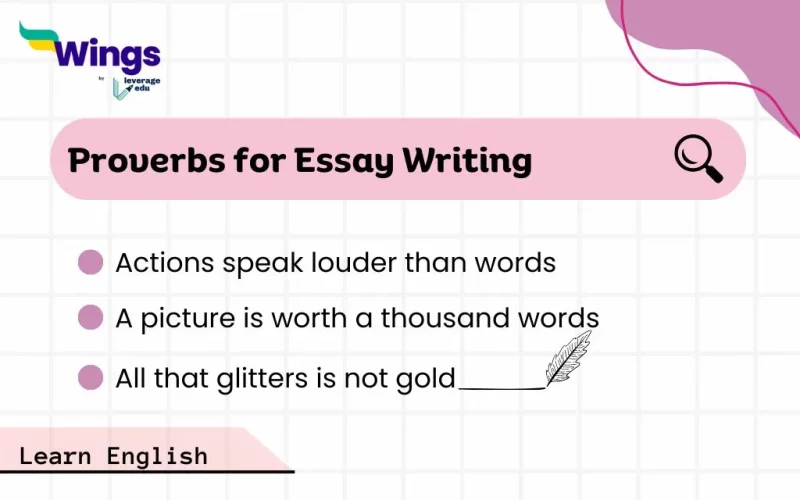
Do you know what makes the English-speaking skills of a native speaker so fluent? It is their proficiency in using English grammar tools such as idioms, phrases, and proverbs effortlessly. Although the three are often confused with each other, especially idioms and proverbs, upgrading your knowledge of proverbial phrases not only advances your vocabulary but also comes in handy while doing essay writing in any language proficiency test or competitive examination . Therefore, in this blog, you will get to learn powerful sayings packed with meaning for crafting impactful essays at par with a journalist.
This Blog Includes:
Why proverbs for essay writing is important, 7 most commonly used proverbs for essay writing in english, 7 quotes and proverbs for essay – upsc , useful proverbs for gre essay writing.
Must Read: 100+ Common Proverbs with Meaning and Examples
There is no denying that proverbs for essays can be your ticket to academic excellence. These wise sayings or proverbs go beyond decoration; they bolster arguments with historical weight and add depth to analysis, making you shine in both high school essays and the GRE exam . Infact, if you plan to appear for the prestigious Indian qualifying exam, UPSC, using proverbs will showcase your cultural awareness and critical thinking skills.
Since proverbs are infamous for conveying complex ideas succinctly and memorably, here are the seven most common proverbs to use in essays, showcasing your profound knowledge of the English language.
UPSC essays demand clear thinking, strong arguments, and insightful analysis. Here are 7 quotes and proverbs to elevate your writing and impress examiners:
“The future depends on what you do today.” – Mahatma Gandhi
Meaning: This quote emphasises the importance of action and taking responsibility for shaping the future. It can be used to discuss topics like social change, environmental sustainability, or individual agency.
“A single conversation with a wise man is worth a month’s study of books.” – Confucius
Meaning: This proverb highlights the value of learning from experienced individuals. It can be used to discuss the importance of mentorship, cultural exchange, or traditional knowledge systems.
“Education is the most powerful weapon which you can use to change the world.” – Nelson Mandela
Meaning: This quote emphasises the transformative power of education. It can be used to discuss topics like poverty alleviation, women’s empowerment, or educational reforms.
“Justice is what love looks like in public.” – Cornel West
Meaning: This quote connects justice with compassion and empathy. It can be used in essays about social justice, ethical leadership, or the role of government.
“Doubt is not a pleasant condition, but certainty is absurd.” – Voltaire
Meaning: This quote highlights the importance of critical thinking and staying open to new information. It can be used to discuss scientific progress, philosophical inquiry, or the need for evidence-based policymaking.
“The greatest glory in living lies not in never falling, but in rising every time we fall.” – Nelson Mandela
Meaning: This quote highlights the importance of resilience and overcoming challenges. It can be used to discuss individual perseverance, national development, or overcoming historical injustices.
“Small deeds done are better than great deeds planned.” – Peter Marshall
Meaning: This proverb emphasises the importance of taking action, even if the steps are small. It can be used to discuss topics like entrepreneurship, community development, or individual initiative.
Quick Read: 9 Best English Proverbs on Education
Just like UPSC essays, crafting a compelling GRE essay requires strong arguments and insightful analysis. Proverbs, those timeless nuggets of wisdom, can be powerful tools in your GRE essay arsenal. Here are some impactful proverbs to elevate your writing:
Find more proverbial reads below!
This was all about proverbs for essay writing and their meaning. Hope you understand the concept and know how to proceed. You can also follow the Learn English page of Leverage Edu for more exciting and informative blogs related to grammar.
Harshita is a creative writer cum literature enthusiast in pursuit to extend her learnings of overseas and Indian education sectors to the masses, through her well-curated articles. You may also find her emerging in prose writing or reading Toni Morrison when not writing stuff related to education.
Leave a Reply Cancel reply
Save my name, email, and website in this browser for the next time I comment.
Contact no. *

Leaving already?
8 Universities with higher ROI than IITs and IIMs
Grab this one-time opportunity to download this ebook
Connect With Us
45,000+ students realised their study abroad dream with us. take the first step today..

Resend OTP in

Need help with?
Study abroad.
UK, Canada, US & More
IELTS, GRE, GMAT & More
Scholarship, Loans & Forex
Country Preference
New Zealand
Which English test are you planning to take?
Which academic test are you planning to take.
Not Sure yet
When are you planning to take the exam?
Already booked my exam slot
Within 2 Months
Want to learn about the test
Which Degree do you wish to pursue?
When do you want to start studying abroad.
January 2024
September 2024
What is your budget to study abroad?

How would you describe this article ?
Please rate this article
We would like to hear more.
Have something on your mind?

Make your study abroad dream a reality in January 2022 with
India's Biggest Virtual University Fair

Essex Direct Admission Day
Why attend .

Don't Miss Out
GMAT Prep Online Guides and Tips
What’s a good gmat writing score does the essay matter.
How much does your GMAT writing score really matter? Business schools only release GMAT score data for their students’ Total scores, so it can be difficult to find information about what constitutes a “good” or “bad” GMAT writing score and how important your GMAT analytical writing score really is.
Luckily, we’ve done the research and figured out the answers for you. In this post, we’ll tell you what business schools have to say about the Analytical Writing Assessment, how they weigh it against other parts of your GMAT score and your overall application, and how your score stacks up against other test-taker worldwide. Finally, we’ll help you figure out what a good GMAT analytical writing score is for you .
How Is the GMAT Analytical Writing Assessment Scored?
The Analytical Writing section is graded on a scale of 0-6 in half-point increments . According to the GMAC AWA score guide, 6 is considered “outstanding,” 5 is “strong,” 4 is “adequate,” 3 is “limited,” 2 is “seriously flawed,” and a 1 is considered “fundamentally deficient.” Like the Integrated Reasoning score, the GMAT writing score does not factor into your Total GMAT score , which is why it’s generally considered to be less important.
Your AWA essay is graded once by a human and once by a sophisticated computer grading program called E-Rater . If the two scores are identical or differ by one point, they are averaged to obtain the final score for that essay. If the scores differ by more than one point, an expert human reader will step in and determine the final score.
Graders are trained to consider the following when assigning a score:
Not sure how or what to study? Confused by how to improve your score in the shortest time possible? We've created the only Online GMAT Prep Program that identifies your strengths and weaknesses, customizes a study plan, coaches you through lessons and quizzes, and adapts your study plan as you improve.
We believe PrepScholar GMAT is the best GMAT prep program available , especially if you find it hard to organize your study schedule and don't want to spend a ton of money on the other companies' one-size-fits-all study plans.

- The overall quality of ideas about the issue and argument presented
- Your overall ability to organize, develop, and express those ideas
- The relevant supporting reasons and examples used
- Your ability to control the elements of standard written English (grammar and syntax), with a bit more leeway given to international ESL students
Along with your scaled score, you will also be given a percentile ranking , which corresponds to the percentage of test-takers whom you scored higher than. For example, if you scored in the 80th percentile on the AWA section, this means you did better on that section than 80% of people who took the exam. This percentile is based on the last three years of GMAT scores, so if you took the test in 2014, your 80th percentile score would encompass all GMAT-takers from 2012 through 2014.
Thus, while scaled scores are static, percentiles can (and do) change over time. Percentiles help contextualize your scores by comparing them with those of other applicants, and they are assessed by business schools along with the scaled score to see how you measure up.

GMAT Writing Score Averages and Percentiles
Most test-takers score highly on the Analytical Writing Assessment: almost half of all test takers score a 5 or higher. The average GMAT Analytical Writing score is a 4.37.
Below are the current percentile rankings for GMAT Analytical Writing scores.
What’s a Good GMAT Writing Score Overall?
Remember, there’s no score on any section of the GMAT—even an 800 Total score—that is guaranteed to get you into your top choice business school. Plus, your AWA score is certainly the least influential score one way or the other. Business schools definitely care far more about your Total score, and it’s likely that they care more about your IR score as well. While no part of the GMAT should be neglected , the AWA is the bottom of the GMAT totem pole in terms of your MBA application.
The ultimate takeaway is that a good GMAT writing score is is the one that doesn’t hinder your acceptance into the MBA program of your choice . We say “doesn’t hinder” rather than “gets you into” because the majority of test-takers do very well on the AWA, which makes it hard to get a score that truly stands out. Even if you score a perfect 6, that’s unlikely to be impressive enough to boost an otherwise so-so Total score , or a poor GPA , etc. In fact, the difference between a 5 and a 6 isn’t going to affect your application much, if at all.
Statements from the GMAC itself confirm this: they explicitly advise business schools to “not make distinctions among applicants on the basis of a small scoring distinction—one point or less apart.”
So while it’s hard to stand out, on the other hand, the fact that almost half of test-takers score a 5 or above is an encouraging sign: with just a little bit of prep , you can easily achieve a GMAT analytical writing score of 5 or higher.
One thing to note is that even though the AWA isn’t that important in the grand scheme of things, scoring below a 4 could raise a red flag . Business schools say very little about how they weigh the AWA, but a low score like a 3.5 might signal to them that your writing skills aren’t developed enough to handle the rigorous coursework of an MBA program. More importantly, a huge gap between the writing level reflected in your AWA and the writing level reflected in your application essay is disconcerting in that it calls into question your authorship of the latter.
The GMAC itself advises business schools to “consider that the scores are based on 30-minute, first-draft writing samples” and cautions that these essays “are not comparable to prepared essays that may be submitted with a school application.” The GMAC rather recommends that business schools use the AWA as a “diagnostic tool in recommending or requiring additional instruction in writing,” though it’s unclear how much universities actually carry this out.

In Summary: What’s a Good GMAT Writing Score for Me?
As a baseline, a 5 is considered a strong GMAT essay score. At a 5 or above, you’ll essentially be fine in that your GMAT essay score won’t hinder your application. For the vast majority of schools, a 5 is a good score.
However, if you’re applying to some top 10 business schools , you might want to push yourself further. To be safe, you should aim to score a perfect 6, or at least a 5.5. A 5.5 or above puts you in the top 20%, which is a safe area to be in for the AWA for an elite MBA program.
A 4.5 is generally an “okay” score. A 4 or below puts you under the average, which could hurt you if you’re an international applicant or if your application essay is far better. If you’re scoring 4.5s or below on practice tests, this signals that you could use a little extra AWA prep before taking the GMAT for keeps.
What’s Next?
Looking to raise your GMAT essay score? Creating an AWA template is an excellent method.
Also, be sure to read through our essential AWA tips and guide to approaching every kind of GMAT essay prompt .
Happy studying!
Was this helpful? Sign up for FREE GMAT and MBA guides!
Share this:.
- Click to share on Twitter (Opens in new window)
- Click to share on Facebook (Opens in new window)
- Click to share on Google+ (Opens in new window)
Author: Jess Hendel
Jess Hendel is a Brooklyn-based academic advisor, test prep tutor, and content writer for PrepScholar. A graduate of Amherst College, she has several years of experience writing content and designing curricula for the top e-learning organizations. She is passionate about leveraging new media and technology to help students around the world achieve their potential. View all posts by Jess Hendel
Niche $10,000 "No Essay" Summer Scholarship
Help cover the cost of college without writing a single essay!
Niche is giving one student $10,000 to help pay for tuition, housing, books and other college expenses — no essay required!
Apply below for your chance to win so you can focus on your education, not your finances. The winner will be selected by random drawing by August 15, 2024. Good luck!
Min 7 characters
By proceeding you acknowledge and agree to our Privacy Policy and Terms of Use .
By proceeding you acknowledge and agree to our Privacy Policy and Terms of Use and Scholarship Rules .
Who Can Apply
All high school and college students, as well as anyone looking to attend college or graduate school in the next year. Please note: Not everyone is eligible for this scholarship. Niche sponsored scholarships and sweepstakes are for people with US citizenship or a valid Visa/US passport only. Read the scholarship rules. Questions? Visit our Scholarship FAQs .
How It Works
The $10,000 “No Essay” Scholarship is an easy scholarship with no essay required! Only one entry allowed per person. The winner will be determined by random drawing and then contacted directly and announced in Niche's e-newsletter and on the Scholarship Winners page.
About Niche Scholarships
We believe cost shouldn’t keep anyone from pursuing a higher education, so we connect students with thousands of scholarships — many of which don’t require an essay — to help them afford college. In 2023 alone, we offered over $285,000 in Niche scholarships. Read more about Niche scholarships here or visit our FAQs .

IMAGES
VIDEO
COMMENTS
An effective GMAT essay template will include the following features: The structure of your essay, paragraph by paragraph. The kind of content that should be in each paragraph. Varied and sophisticated pre-written sentence stems (as in, the beginning part of a sentence) for the main kinds of flaws.
The GMAT Analytical Writing Assessment requires you to write an essay, using a basic word processor, that critiques a provided argument. It is the first section of the GMAT and is to be completed in 30 minutes. The AWA is scored by two readers in half-intervals on a scale of 0-6.
The GMAT Analytical Writing Assessment (AWA) provides clear instructions on how you should plan and write your essay. Kaplan students learn these instructions long before Test Day and do not waste precious testing time reading them while the clock ticks. Kaplan GMAT students learn the Kaplan Method for AWA and the Kaplan template for structuring the essay into paragraphs.
For one, you will write a better analysis if you imagine yourself tied to the argument in some way, and two, the prompt asks you to strengthen the argument. Find some general evidence that will make the argument more convincing or make it irrefutable. Suggest a change so that the logic stands on firmer ground.
The Analytical Writing Assessment (AWA) is a 30-minute section of the in-person GMAT that consists of one essay task, an "analysis of an argument.". Depending on what section order you choose for your exam, you'll complete the AWA section either first or last when you sit for your GMAT. If you choose the default section order, the AWA ...
The essay portion of the GMAT, or the Analytical Writing Assessment, is unlike most of the essays you've written for college. You're given a single, one-paragraph prompt containing some kind of argument, and rather than picking a side and building your own case, you have to critique how that argument is made.. Luckily, we've done the hard work of analyzing GMAT essay questions for you.
Introduction to the GMAT AWA Task. The Analytical Writing section on the GMAT (often referred to simply as the AWA) is possibly the one with most diametric opinions. Some people actually look forward to the opportunity to break out of the multiple-choice format and to present their thoughts on paper, while others are terrified by the prospect.
Step 1: Understand the Issue. The first step towards strong essay examples is to understand the two sides of the issue. You must either strongly agree or strongly disagree with the presented issue. Unlike real life where most of your opinions are probably a mix of gray, the GMAT Issue essay requires you to take a strong stand on one side of the ...
The Analytical Writing Assessment (AWA) section, consisting of one 30-minute essay, measures the test taker's ability to formulate an appropriate and constructive critique of a specific conclusion based on a specific line of thinking. The AWA score is an average of the two independent ratings. Scores average from zero to six, in half-point ...
The easiest format to use in writing this essay is the classic 5-paragraph style, and a simple, effective format will look something like this: Paragraph 1: Brief recap of argument and statement that the argument has merit but also contains multiple flaws. Also include a "roadmap" of the points that you will make, in the order that you will ...
GMAT Write - An AWA practice tool by GMAC. GMAT Write is a writing tool provided by GMAC. It gives you access to 2 unique essay prompts and a chance to write 4 essays. The good thing about this tool is that it scores your essay based on the scoring algorithm used by the official GMAT exam. But, it costs $29.99 to subscribe to this tool.
Nobody Reads Your MBA Essays, Part I. If you've ever attempted to write a really good essay for an MBA application (or for any other graduate or undergraduate program), you know how hard it is. It's not like crapping out a financial report or a blog post or an essay on the use of soliloquies in Hamlet.
The GMAT is scored on a scale between 200 and 800. Test takers receive five scores: one for each of the four test sections, plus the total score, which includes the verbal and quantitative ...
According to the Graduate Management Admission Council (GMAC), a score of 6, the highest possible score, is considered "outstanding," 5 is "strong," 4 is "adequate," 3 is "limited," 2 is "seriously flawed," and 1, the lowest score possible, is considered "fundamentally deficient.". Your GMAT AWA essay will be graded once ...
2. On the AWA, you need to be a lawyer, that is, you need to find faults with the given argument. You do not need to be a journalist, that is, you do not need to write about all possible perspectives of an issue. Also remember, that this is an analysis, not an opinion piece. Do not bring YOUR perspective and your opinions into the essay.
Another one of the important GMAT writing tips is to take the time to set up your essay in a clear way. You don't need to write the most interesting or lengthy essay in the world to score well on the AWA section, but you do need to give your essay an easy-to-follow structure. Usually, that consists of an introduction, three to four well ...
Well, for starters, the schools do care if you score in about the bottom 20% of test-takers on the GMAT essay—so you want to make sure that your score is higher than that. A score of 4.5 (43rd percentile) is good enough, and even a score of 4.0 (20th percentile) is probably good enough. (Note: the GMAT essay scoring scale goes up to 6.0.)
Sample high-scoring essay. The financial planning office of Fern Valley University suggests that a fundraising campaign be initiated in order to increase the range of subjects taught at the university and to expand library facilities. The goal is mainly to halt the declining number of students and admissions by addressing these two issues.
1st Paragraph: About Yourself. Introduce yourself and provide a concise overview of the specific criteria that make you eligible to submit the GMAT/GRE waiver request letter. Explain the purpose of your letter, detailing why you are writing and specifying the nature of your request.
5. Final tips. During the tutorial type in a few sentences in the mock essay window to get used to the keyboard. Again during the tutorial, jot down on your notebook the basic structure of your essays or the opening sentences in case you get too nervous and forget them when the clock starts ticking.
These changes are outlined below: Reduced Exam Duration: The GMAT Focus Edition has three 45-minute sections. This makes the test significantly shorter, giving test takers back an hour or so of their time. Streamlined Content: The GMAT Focus Edition retains the Quantitative and Verbal Reasoning sections. Quant will continue to test problem ...
Exam Prep. GMAT™ Official Guide 2024-2025: eBook & Online Question Bank.
GMAT Essay: Format, Scoring, and Tips for the AWA. March 5, 2018. The GMAT Analytical Writing Assessment (AWA) can be one of the most intimidating sections of the exam for test-takers. Many students feel unsure of what is expected of them on the GMAT essay or how it's scored. But there's nothing to fear as long as you prepare!
After drafting, take the time to revise and polish your writing. Seek feedback from teachers, mentors, or trusted friends, but ensure the final piece is unmistakably yours. A well-crafted essay ...
UPSC essays demand clear thinking, strong arguments, and insightful analysis. Here are 7 quotes and proverbs to elevate your writing and impress examiners: "The future depends on what you do today.". - Mahatma Gandhi. Meaning: This quote emphasises the importance of action and taking responsibility for shaping the future.
Students may also take it for an intriguing academic journey. You get a chance to pursue academic progress, career development, and personal growth. Your primary task will be to write a transfer essay. It's a valid framework for clarifying your position. Find some available transfer essay examples to gain a general understanding.
At a 5 or above, you'll essentially be fine in that your GMAT essay score won't hinder your application. For the vast majority of schools, a 5 is a good score. However, if you're applying to some top 10 business schools, you might want to push yourself further. To be safe, you should aim to score a perfect 6, or at least a 5.5.
Help cover the cost of college without writing a single essay! Niche is giving one student $10,000 to help pay for tuition, housing, books and other college expenses — no essay required! Apply below for your chance to win so you can focus on your education, not your finances. The winner will be selected by random drawing by August 15, 2024. Good luck!